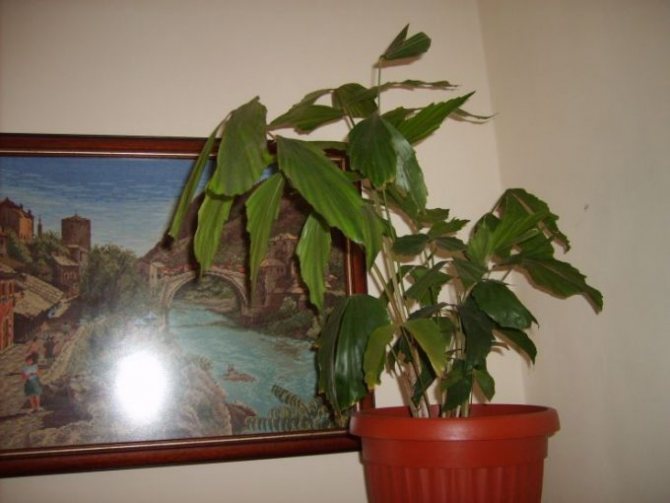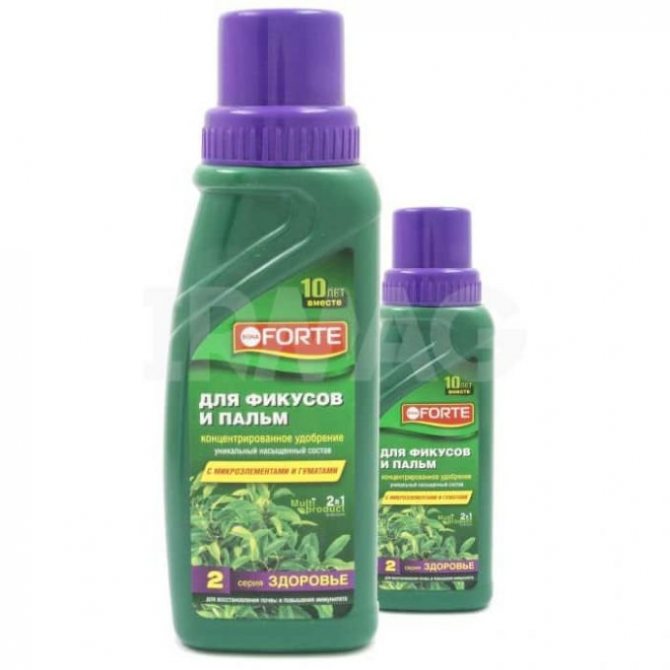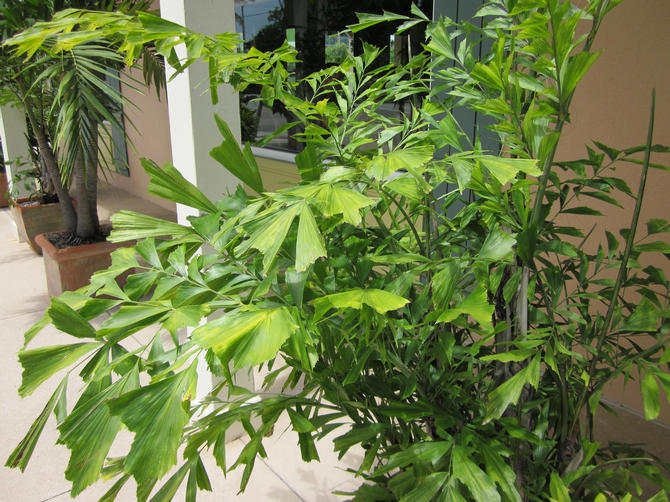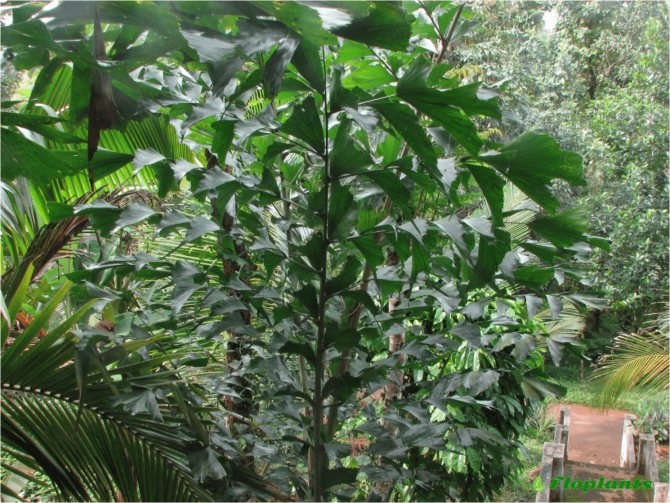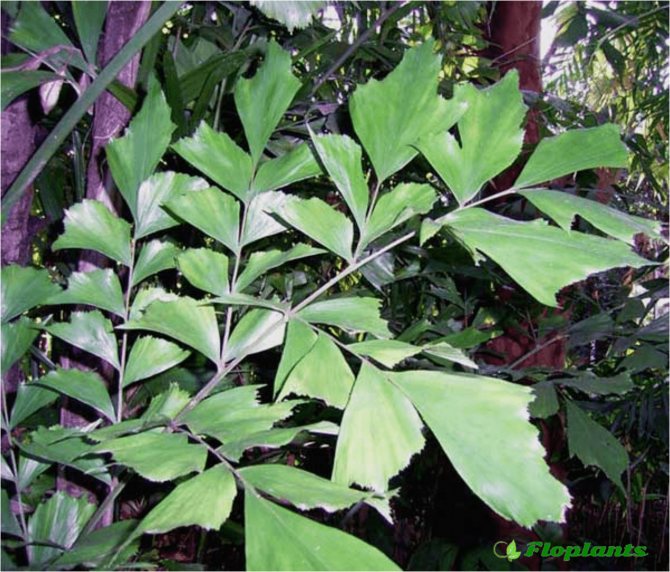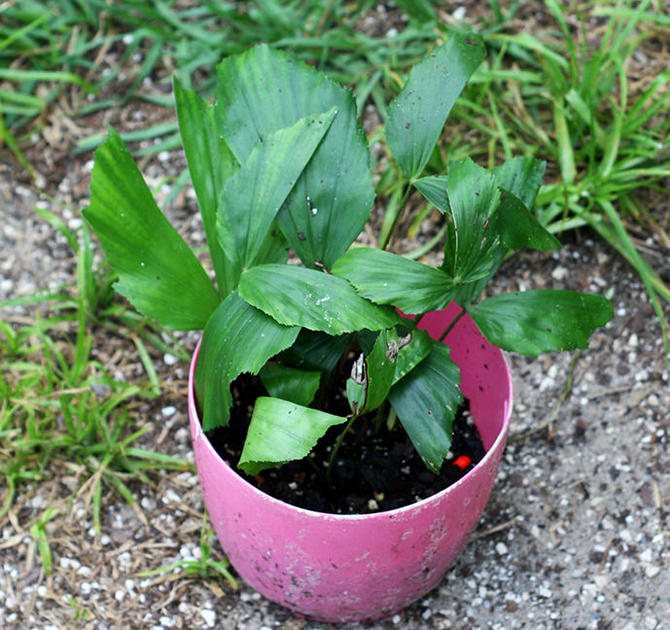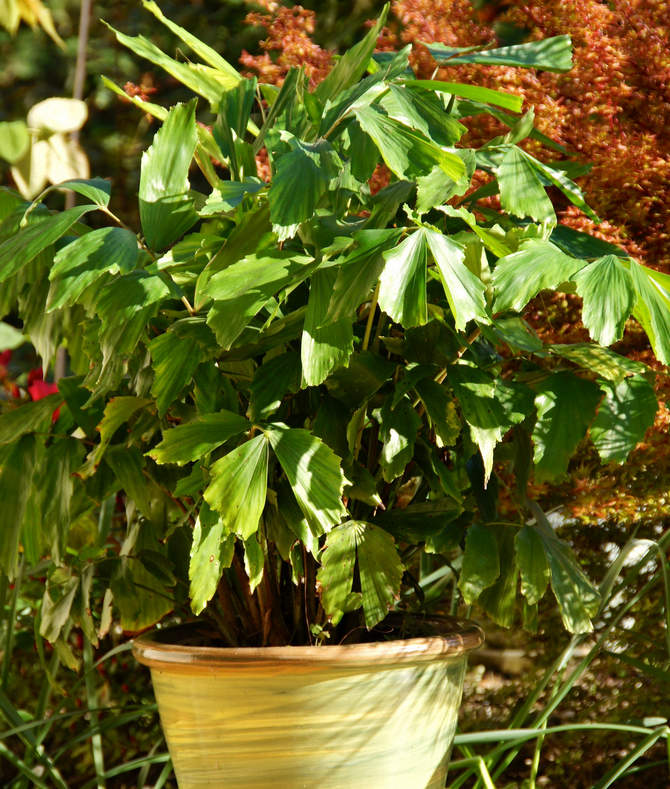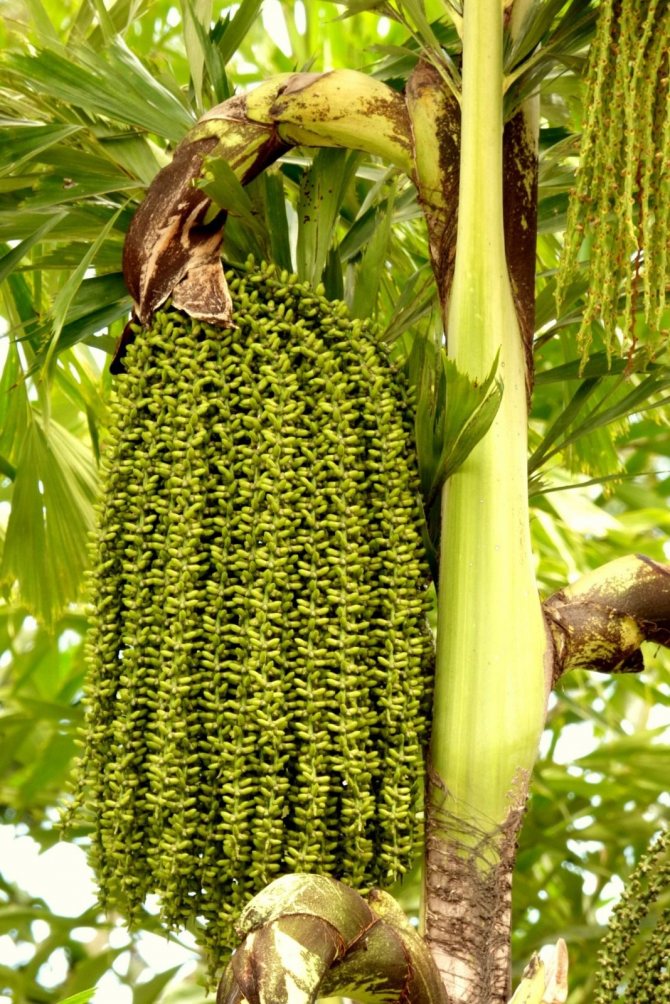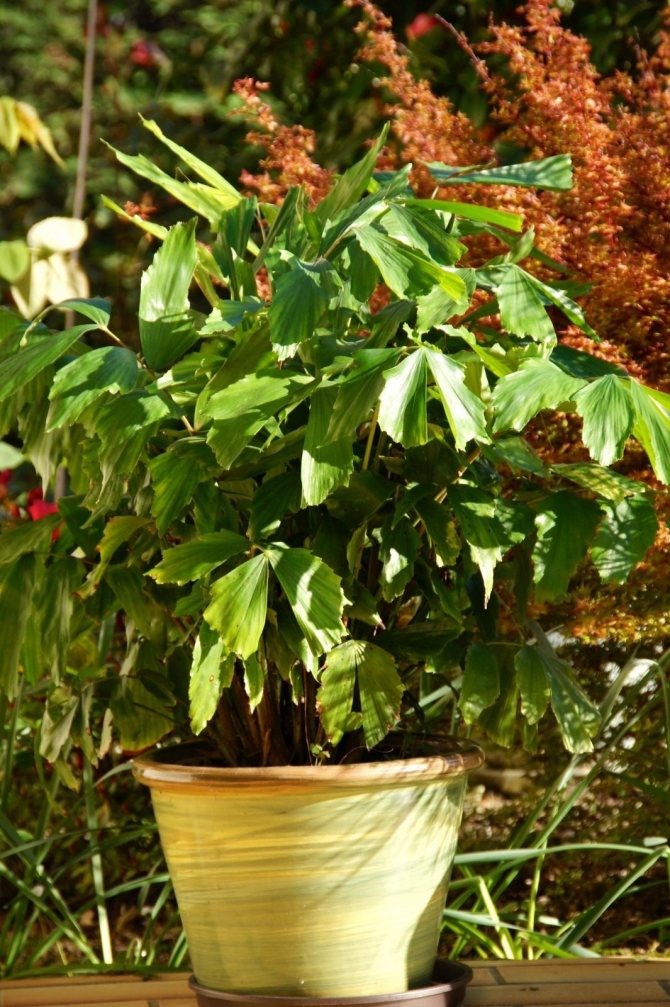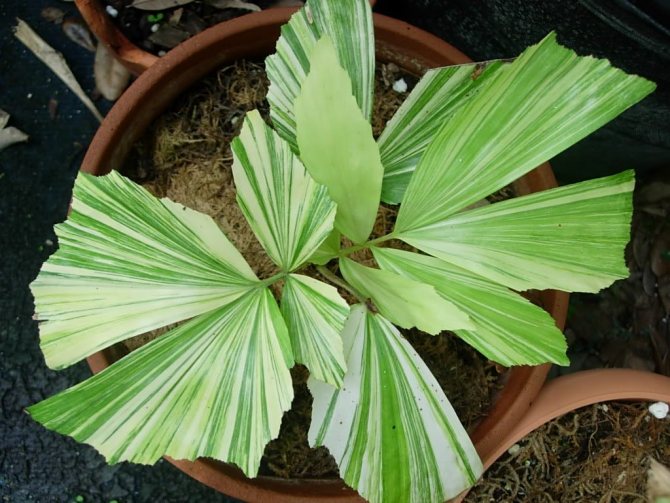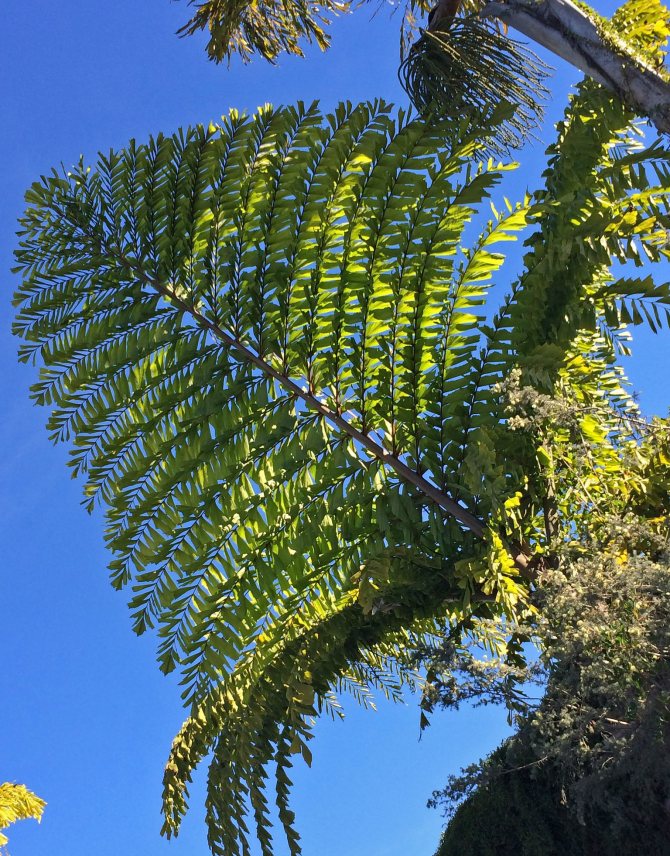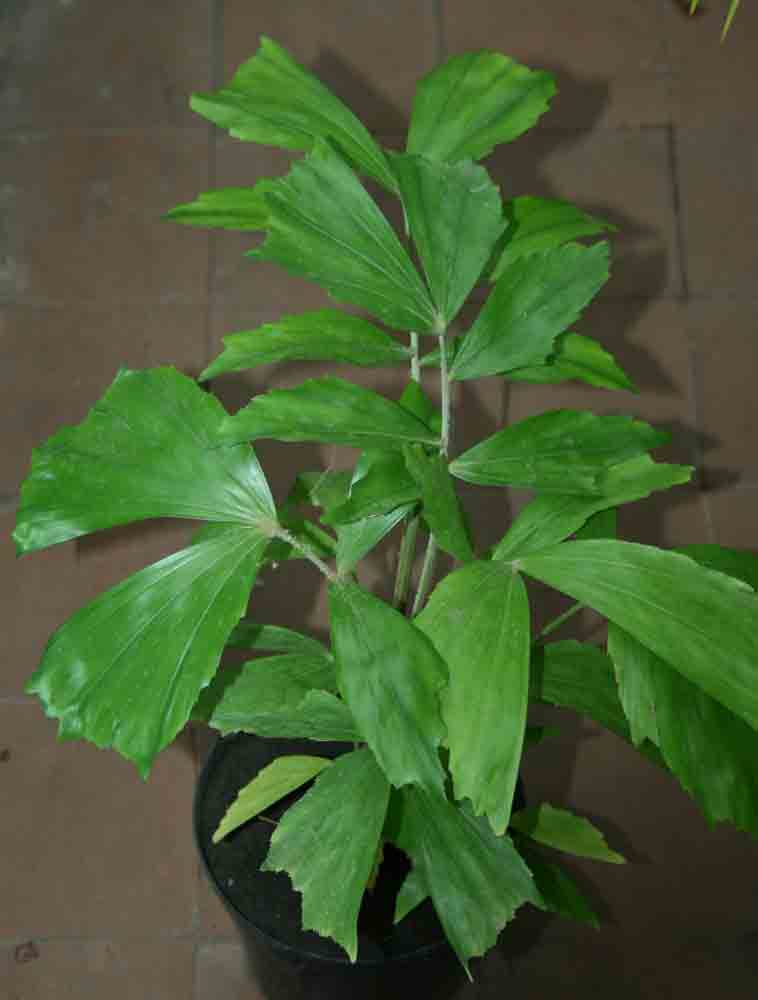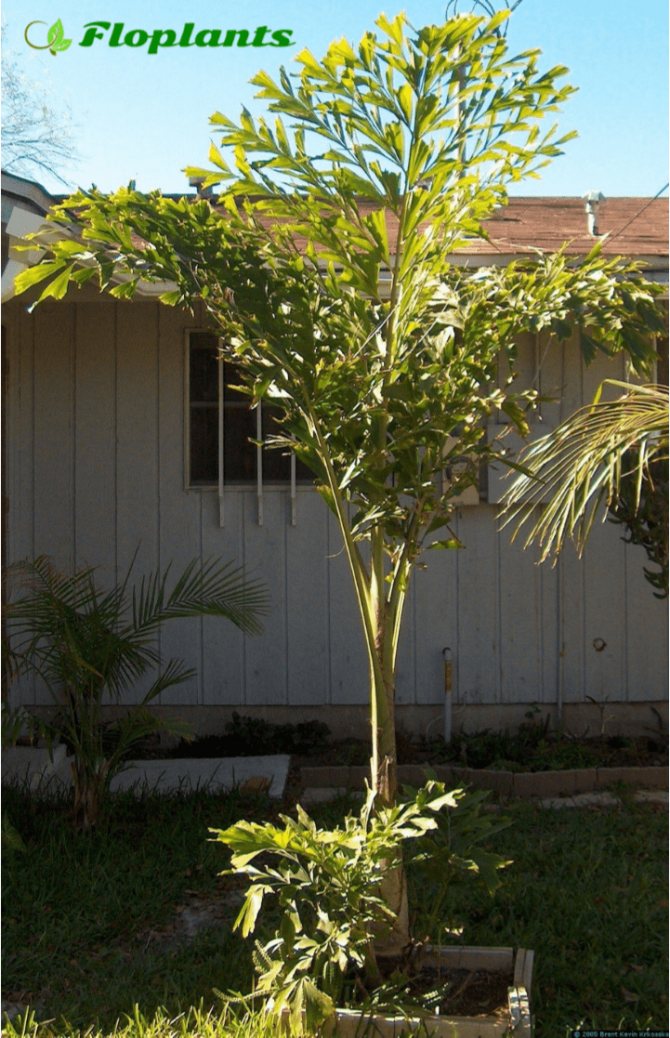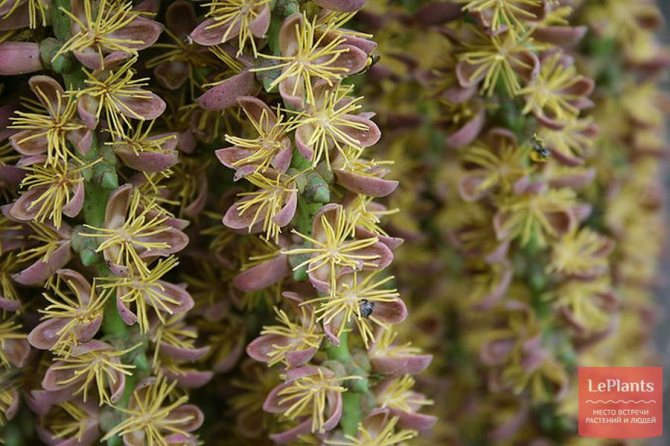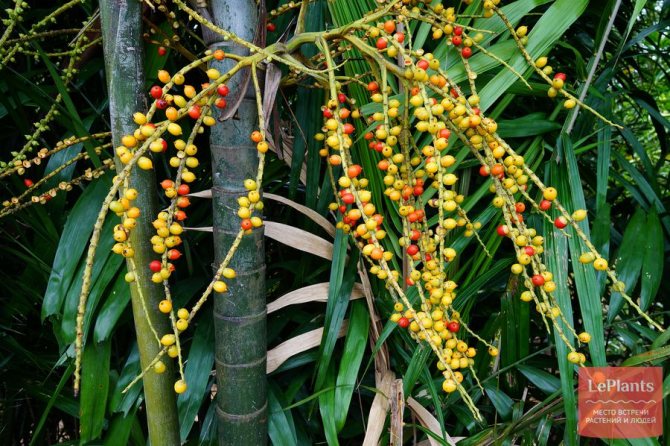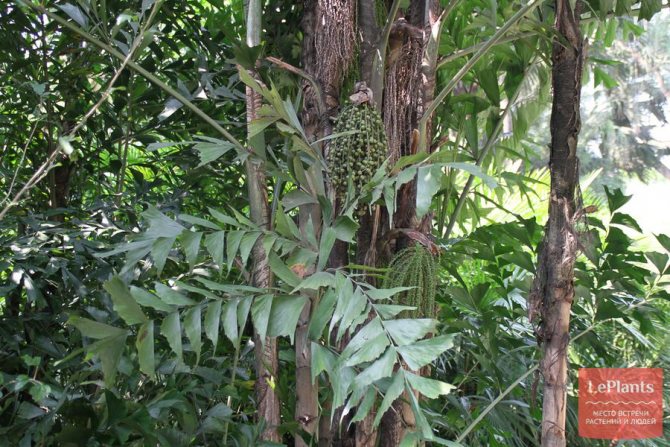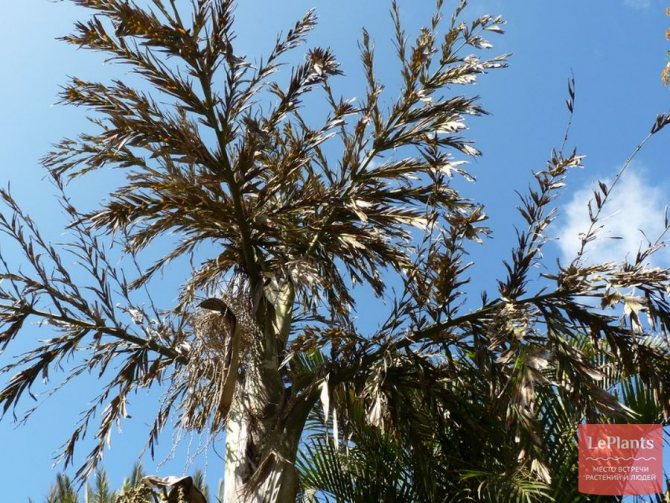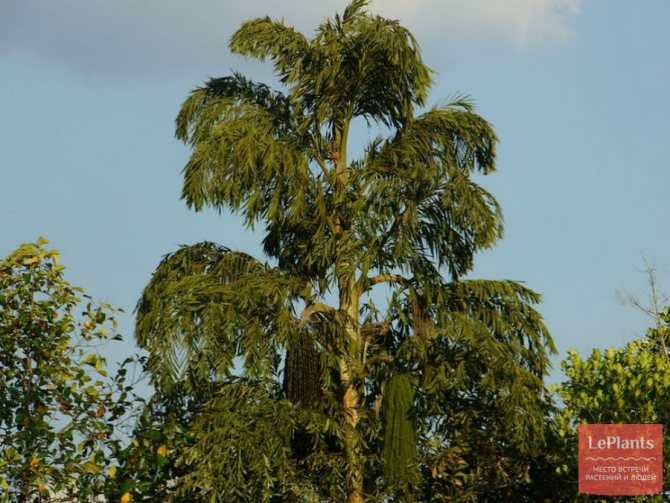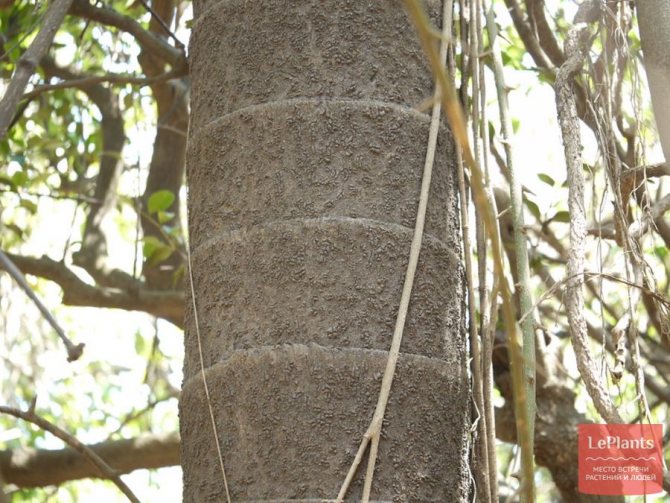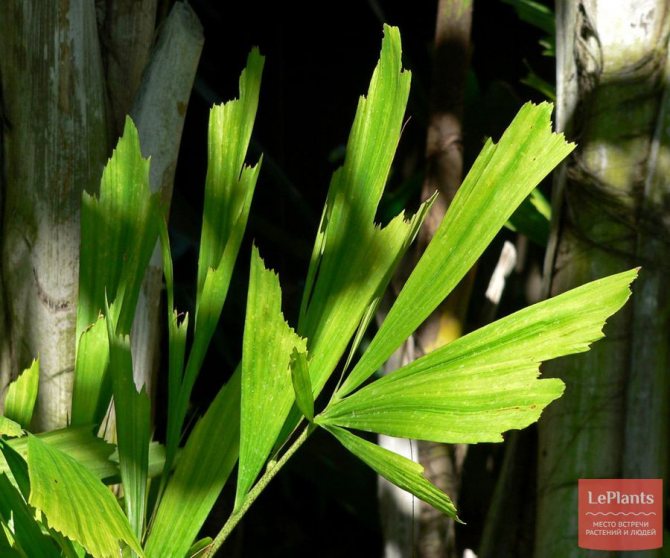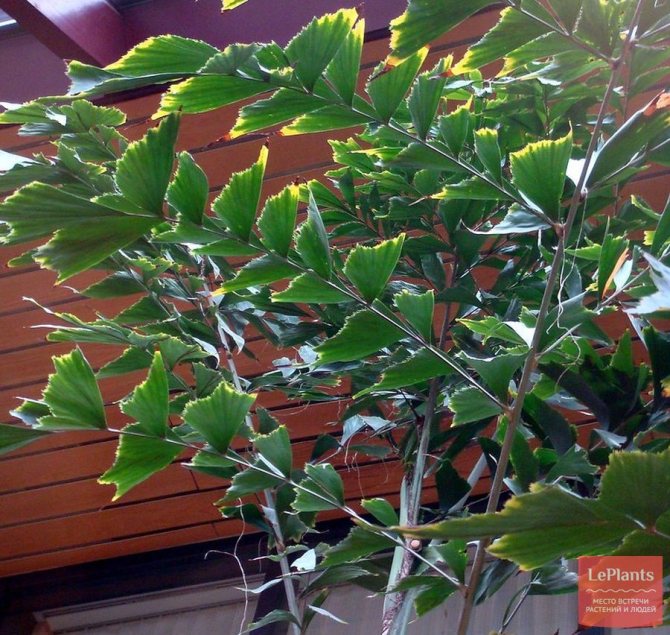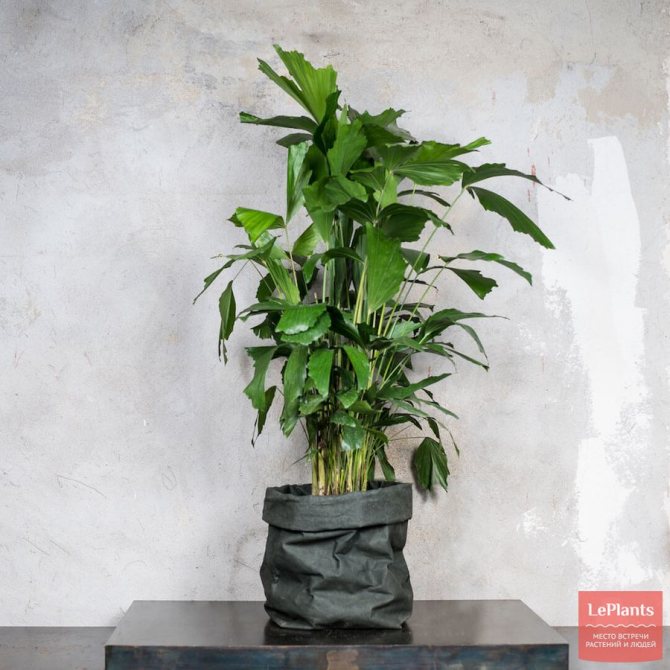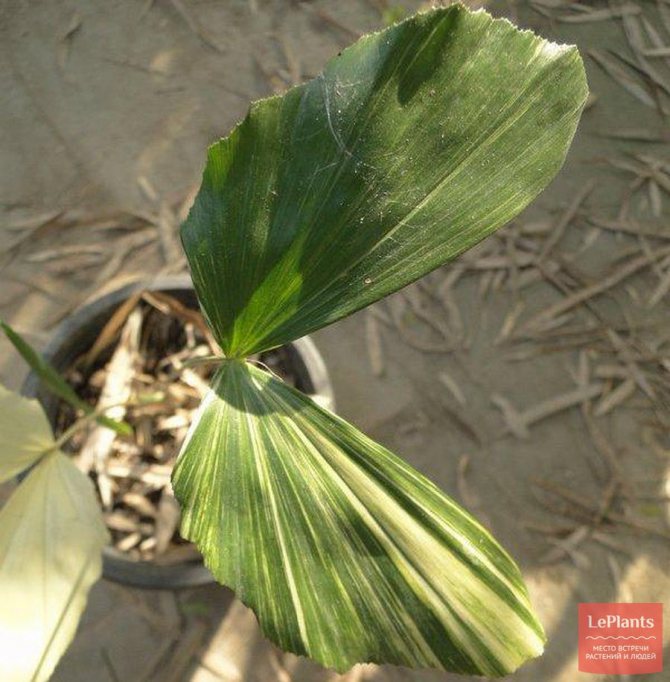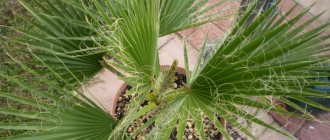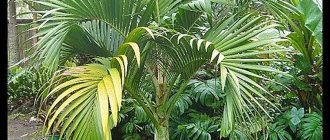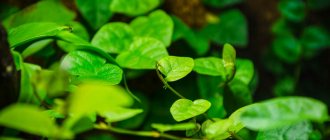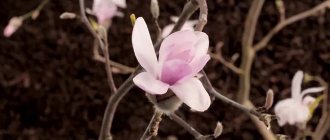Category: Care Published 03/24/2019 · Comments: · Read: 10 min · Views: 429
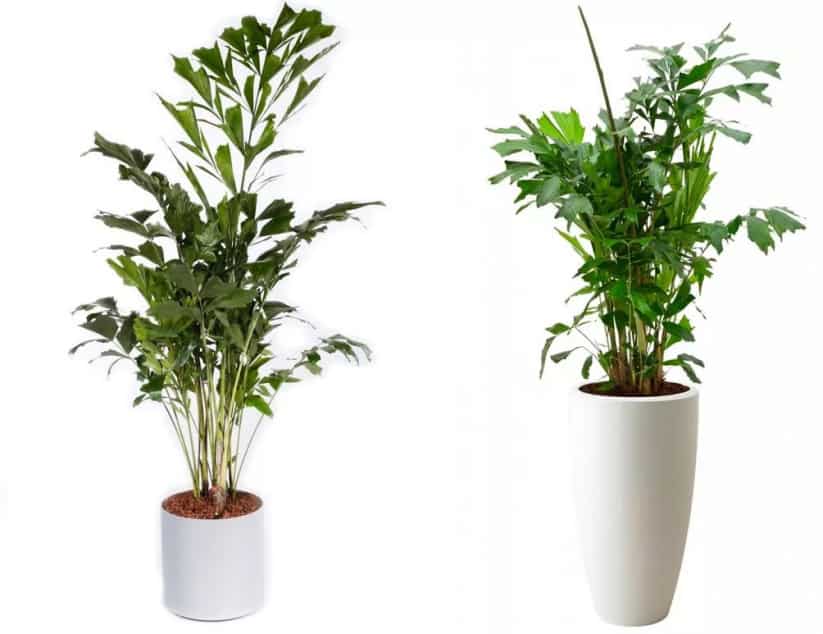
Fishtail, mermaid, wine palm ... All these nicknames refer to the caryote palm - an exotic representative of the flora, which is successfully grown at home. The plant differs from other palm trees, and not only externally, the karyota has both advantages and disadvantages, which the owner should know about in advance.
Is the caryote palm difficult to grow, how to properly care for it so that the pet feels comfortable and looks spectacular?
Growing cariota
Recommended luminous flux - should be moderate and not too bright. Despite the fact that the plant is tropical, it is undesirable to expose it to direct sunlight. Ideally, place the pot near the southeast or southwest window. Insufficient lighting can slow down the growth of a palm tree.
The soil can be purchased or prepared by yourself. The acidity level of the soil is slightly acidic or neutral. The "correct" soil is made up of clay-sod and humus-leaf soils in a ratio of 1: 1. Sand, peat and rotted manure should be added to it.
In the warm season - water abundantly, but without excess. In cold weather - in moderation, so that the soil in the pot is slightly moistened. Spraying of leaves is carried out 1-2 times a day in the warm season, in winter - the frequency of spraying is reduced. The water should settle and be warm.
The year-round temperature level, which is necessary for a palm tree, hovers around 14-18 degrees. If the room temperature is above this value, the leaves need to be sprayed more often.
... To prevent the palm tree from dying, the temperature should not be allowed to drop below 12-13 degrees.
It is necessary to feed the palm tree during the warm season (from May to September). Special fertilizer for palm trees is applied once a month. As fertilizers, you can use the preparations "Ideal" or "Rainbow". Dormant feeding can damage the plant.
Care and maintenance conditions of the caryote palm
In indoor floriculture, the mitis caryote is most often grown, it is also called soft or tender. If you take proper care of it, then from a small palm it will soon turn into a large, 2-2.5 meter tree. This will take her 3-4 years.
But if the florist is not ready to become the owner of such a tall pet, then this process can be slowed down by replanting the specimen only when urgently needed, when its roots will not fit in the old container.
The second most popular fishtail palm is the pungent caryote. It got its name from the fruits containing a large amount of oxalic acid. The plant has triangular leaves and can also reach 2.5 m in height at home.
Despite its exotic origin, impressive size and unusual, luxurious appearance, the caryote is well adapted to home conditions. She does not need the obligatory cold wintering, easily reproduces through vegetation, does not require complex care and special manipulations. It can be grown not only by experienced palm experts, but also by novice flower growers. However, it is advisable for the owner to take into account her natural needs and habits so that problems do not arise.
Lighting for an exotic tree
Cariota is photophilous, but does not tolerate direct sunlight very well. They can seriously damage the leaf plates of a palm tree, leaving severe burns on the surface. Therefore, it is desirable to provide an exotic plant with diffused lighting:
- At the windows on the south side, put a pot of caryote not on the windowsill, but next to it, blocking it with a shading screen. And also it can be placed in the interior, but so that the plant has enough light.
- But on the east or west window, the palm tree will feel as comfortable as possible and without additional measures.
- When placing a pet, it is important to take into account that it is harmed by overheating of the roots, which means it is best to put the container on the floor or on a low stand.
- The location will be ideal if the light hits the plant from above.
Shading, even small, tropical light-loving beauty is unlikely to like it. This will lead to a slowdown in its growth and the subsequent loss of decorativeness.
About comfortable temperature conditions
Practice has shown that the living environment in which a person lives comfortably is also suitable for these representatives of the flora. Cariotes do not need a cool winter rest, in addition, they do not tolerate a drop in air temperature below +18 degrees. With a more significant cooling, this palm tree may die, but in warmth and even heat, it feels great.
The higher the thermometer rises, the more humid the air should be. The optimum temperature is from +22 to +24 degrees. Many domestic palm trees prefer to be outdoors in the warm season, but not caryote. She is more comfortable staying at home, as the sudden change in climate will cause a lot of stress. But she also does not like drafts, but it can seem very "appetizing" for many pests.
Mermaids prefer stability, including lighting and room temperature. And it is undesirable to disturb them by moving unnecessarily, especially for large specimens.
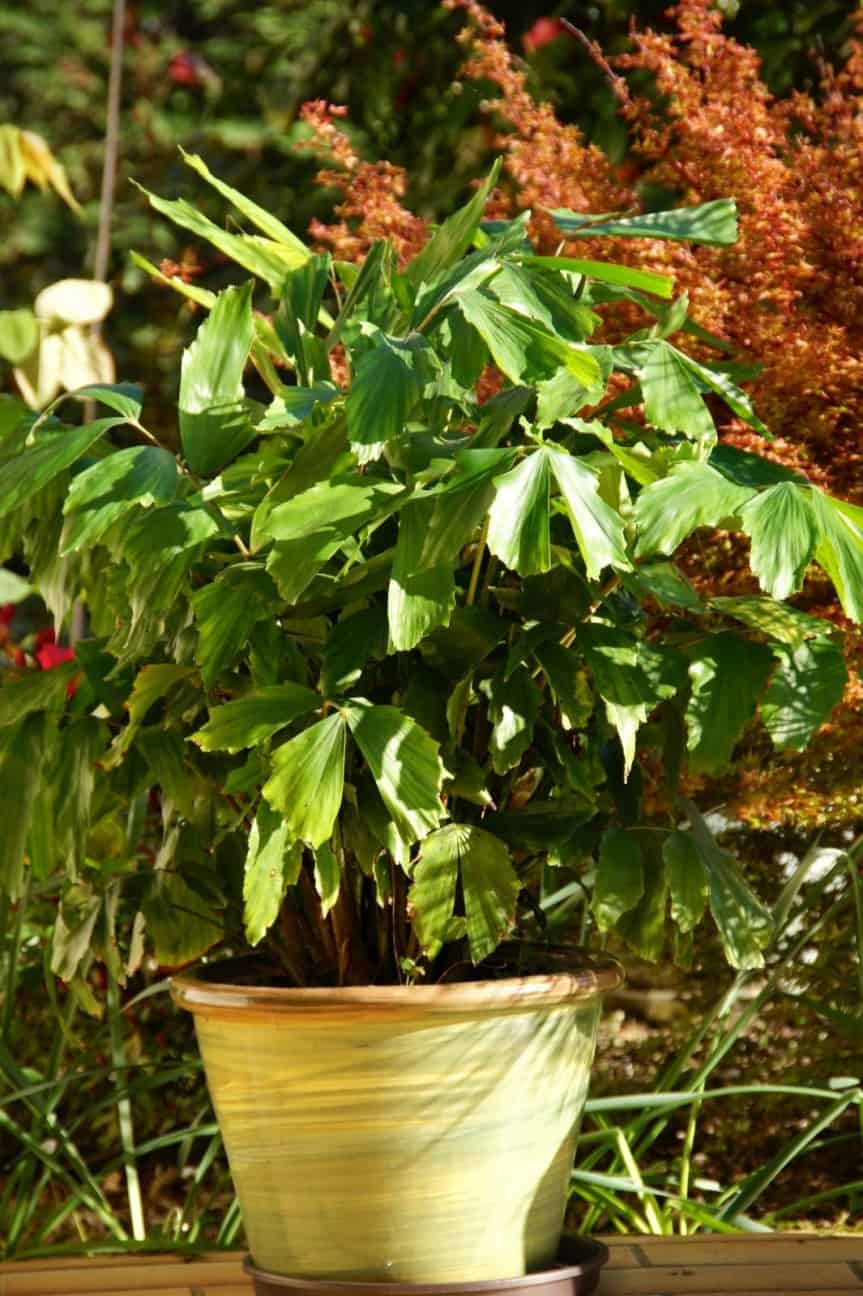

Irrigation mode
Setting a watering regime for this tropical beauty will not be difficult even for a novice grower. It is worth paying attention to the following points:
- It must be adjusted so that the substrate is always slightly damp.
- Palma is equally harmful to both excessively wet and dry soil. Moreover, when underfilling, the caryote partially sheds its leaves, which negatively affects its decorative appearance.
- During an active growing season and in hot weather, the palm is watered more abundantly, adding water after the top layer dries.
- In the autumn-winter period, the plant also needs watering, but they become more rare. So it is recommended to water it only after the top layer of the soil has dried to a depth of 4-5 cm. Regardless of the season, you should drain the water that accumulates in the pan.
For any water treatment, be it irrigation, or watering, water should be used soft. It is pre-defended so that chlorine and other harmful impurities evaporate and it becomes comfortable at room temperature.
Air humidity
This indicator should be high, which means that the owner of the palm tree needs to artificially maintain it, especially during the heat and the operation of heating devices. A humid environment for a tropical plant is necessary for a comfortable existence.
With the right approach, it will be possible to do without the installation of industrial devices that humidify the air. So, the palm tree loves regular, best of all, daily, spraying. This measure is much more effective than placing near water tanks.
In addition, it is recommended to frequently wipe the tree leaves with a soft, damp cloth, moisturizing them and removing dust and dirt.
How to fertilize karyote?
Like most indoor flowers, these palms need additional feeding during active growth - in the spring and summer. They are brought in once a week, using for these purposes not universal, but special mixtures intended for representatives of the palm family.
It is important to pay attention to the composition of the dressings, the active substances of which must be well balanced. The palm tree will harm both the lack of valuable nutrients and their overabundance, this will lead to a violation of the development of the specimen. The ratio of the main microelements N-P-K = 9-3-6 is considered ideal.
And also it is worth focusing on the following aspects:
- In winter and autumn, you do not need to feed the palm tree.
- It is not recommended to fertilize it by foliar methods.
- Fertilizers with a long (prolonged) effect are not suitable for Cariote.
At an air temperature below normal, it is not worth feeding a palm tree for another reason - many active ingredients in such conditions are not able to be absorbed.
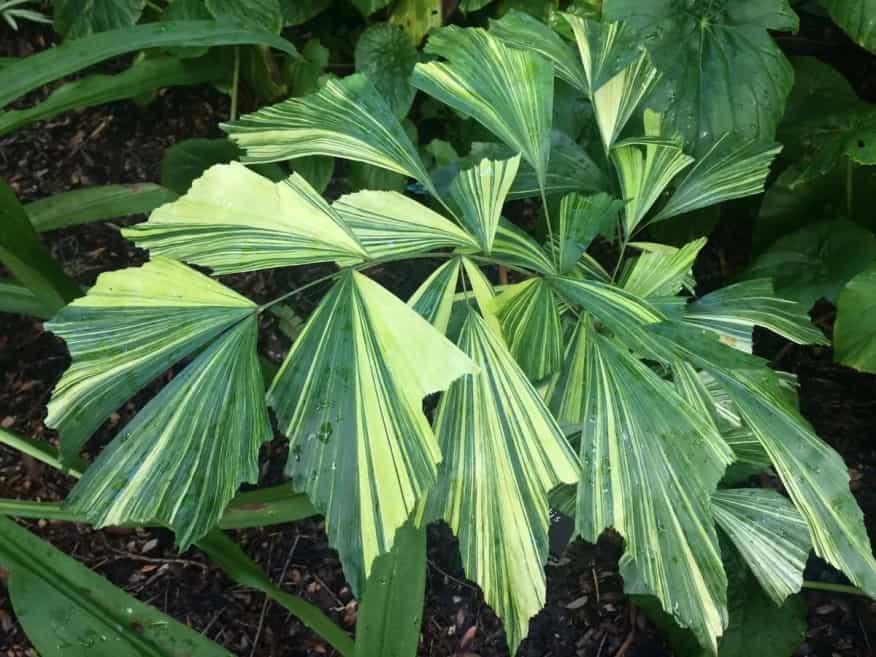

Transplantation rules and soil mixture quality
As it turned out, karyotes are not particularly sensitive to soil quality, so any universal substrates are suitable for them. The main conditions are that they must be of high quality, water and air permeable.
You can purchase a ready-made composition or prepare it yourself by mixing a number of components in equal proportions:
- sod land;
- coarse sand;
- humus;
- compost.
Any drainage material should be placed on the bottom of the pot - ceramic or clay shards, fine gravel, pebbles, vermiculite, pieces of foam. It will eliminate the likelihood of moisture stagnation in the soil.
The capacity for the plant must be chosen suitable, it must be stable, but high, and this is despite the fact that the multi-stemmed varieties grow in breadth. Cariotes have powerful, well-developed taproots that go deep into the ground. When picking up a pot before transplanting, you need to take it with a larger volume, by 5-7 cm.
There is no need to disturb the "mermaid" unnecessarily, even for young specimens one "move" in 2 years is enough. Adult palms are transplanted no more than 1 time in 3-4 years.
It is recommended to use the most delicate method of "transshipment", in which the old earthen lump is almost completely preserved. Unless, if necessary, you can carefully remove the top layer of soil, but without touching the roots themselves. Injury to the root system of a palm tree often leads to the death of the plant.
Transplantation and methods of reproduction of karyote
Cariota, like many palm trees, does not like transplanting very much, so it is extremely rare to do it. Basically, this is done when the pot becomes small for an overgrown plant. Shrub forms of palm are most often propagated by offspring. The offspring from the mother plant is separated after the appearance of several roots and placed in the sand. The optimum temperature for rooting is 20-22 ° C. Until the plant takes root, it is best to avoid direct sunlight.
Breeding plants with seeds is less common, since the germination process is very painstaking, and the seeds will lose their germination when stored for a long time.
The seeds are planted 1 cm in a moist warm soil and covered with a protective screen, the role of which is played by plastic wrap or ordinary glass. Before planting, the seeds are soaked for a day in a solution of Zircon. Sowing must be inspected and ventilated daily. The protective screen is removed only after the plant gets stronger (approximately 2.5-3 months). After that, healthy seedlings of the caryote palm are transplanted into different pots.
It is worth knowing that young plants are deprived of a dormant period, so the conditions for germination should be even.
Reproduction
Karyotes are propagated by seeds, and multi-stem species, such as soft karyote, vegetatively - by separation of basal offspring.Seeds at a temperature of + 22 + 25 ° C sprout within 2-4 months, but sometimes it may take up to 8 months for germination.
After the separation of the offspring with a small number of their own roots, they must be planted in wet sand and must be placed in a greenhouse with high air humidity and a temperature of about +22 o C. It will take several months to restore the root system and start new growth.
Pest detection and control
Cariota pests are,. These insects are standard for all palm species. With an excess of moisture, mushroom mosquitoes can start. So that the palm does not get very sick and does not die, regularly and carefully inspect it, periodically treat your pet with fungicides and insecticides.
The most important rule: follow agricultural practices and regularly carry out hygiene measures. Then your palm tree will grow great and delight you!
Soft cariota (tender) (Caryota mitis)
Cariota palm
easily identified by the characteristic bifurcated leaves with "torn" edges. The leaves of this palm are shaped like a fish tail.
The genus includes 12 plant species that grow in India, Indochina, Southeast Asia, and the Malay Islands.
Interestingly, sugar and wine are made from the juice of some palm trees of this genus.
Most often grown at home karyote soft, or tender
(Caryota mitis)
.
In nature, the cryote palm can grow up to 10 meters and more.
If you take good care of the cariota, then it grows quite quickly at home. A palm tree can grow up to 2.5 meters in a few years. But if you do not need a tall plant, then the growth of the karyote can be limited by replanting it only if the roots are already crawling out of the pot.
Another type, but less common burning cariota
(Caryota urens)
, which got its name due to the salts of oxalic acid contained in the fruits of this palm tree. Cariota pungent has leaves of a triangular shape. In height, this type of palm tree can also grow up to 2.5 m. Another name for the palm tree is wine caryote.
Cariota palm, home care.
The temperature throughout the year should be maintained at a level of 14-18 ° C, since a moderate temperature is required for good health, even in the summer period you need to try to make sure that it does not rise above 18 ° C. If the temperature is above 18 degrees, then it is necessary to increase the spraying frequency. In winter, the temperature should not drop below 13 ° C.
The lighting is moderately bright. Despite the fact that the karyote needs a lot of light, active direct sunlight can harm it. It is best to keep the palm by the "southwest" or "southeast" window. In winter, the lighting should also be fairly bright.
Watering the caryota in spring and summer should be abundant, but excess moisture in the plant pot should not be allowed. In winter, the palm is watered sparingly, and the soil in the pot should be slightly damp.
Caryote leaves should be sprayed with warm soft settled water. If it stands next to heating sources, then it can be sprayed 2 times a day - in the morning and in the evening. In winter, caryote is sprayed less frequently.
The soil for growing karyote should be chosen slightly acidic or neutral. The soil mixture should consist of clay-sod land and humus-leaf soil in a 1: 1 ratio with the addition of peat, rotted manure and sand. You can also use ready-to-use potting soil made for palm trees.
The feeding of the karyote is carried out from May to September every two to four weeks. You can use a fertilizer specially formulated for palm trees.
The karyote should be transplanted as rarely as possible, since, like most palms, it does not tolerate transplanting well.Transplanting a karyote is carried out only when the pot has become clearly small for the plant.
Reproduction of karyote occurs by seeds, which are planted to a depth of about 1 cm in moist warm ground, after which it is covered with glass or polyethylene, and removed only after 2-3 months. The hardened karyote seedlings are planted in separate pots.
The flowering of karyota, as a rule, does not occur at home.
Caryota soft or tender (Caryota mitis)
Diseases and pests of karyote.
Caryote leaves turn yellow
if the plant is not watered enough. The intensity of watering should be increased, while it is necessary to ensure that there is no excess moisture in the pot.
Also, palm leaves turn yellow from lack of nutrients. In this case, you need to make additional feeding.
Caryote leaves brown tips
... These are the consequences of excess moisture, it is necessary to reduce watering, check drainage, and let the soil dry out before the next watering.
Light dry spots on caryote leaves
appear from an excess of light. In this situation, you should rearrange the pot in partial shade.
Caryote leaves darken and wither
from too low room temperature. Observe the recommended temperature regime for this palm tree.
Pests of cariota are scale insects, spider mites, mealybugs.
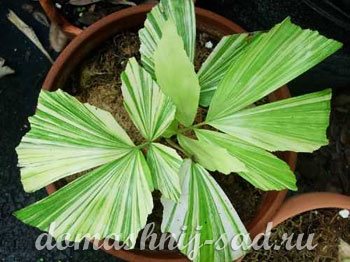

Fishtail or Cariota is a plant from the numerous arec family. This is a type of decorative palm tree growing on the islands of the Malay Archipelago and reaching a height of no more than one and a half to two meters, flowering is rare. Leaves, cut in half with ragged edges, resembling a fish's tail, for which it got its name.
It is also called a walnut tree, as in translation Caryota means "nut, nut".
About diseases and pests of an exotic pet
The caryote palm is not the most invulnerable houseplant, however, most often the occurrence of problems is associated with improper care and maintenance:
Insect infestation
The main pests for this green pet are mealybugs, spider mites, and scale insects. All of them can seriously harm the plant, sucking out nutritious juices, and many provoke secondary infections.
If the specimen is slightly damaged, it is enough to isolate it from other home flowers and carry out several treatments of the foliage with soapy water at weekly intervals.
If the insect colony has increased significantly, then it is recommended to fight them with the help of insecticidal preparations.
Development of spots, rot and fungal infections
Again, palms get sick, which suffer from inappropriate conditions, weakened from other ailments, or difficult to tolerate adaptation. Most often, they show signs of late blight and fusarium.
It is important to identify diseases in the early stages of development and immediately begin treatment. Therapy should be comprehensive; fungicides are used when a palm tree is affected by pathogenic fungi.
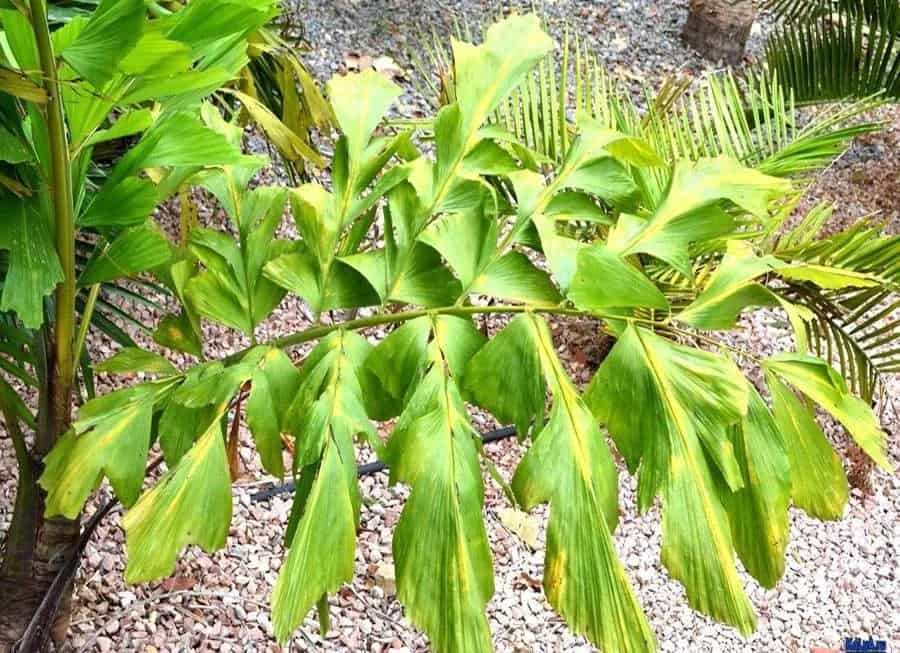

Care
She loves the sun, but only diffused light, she begins to hurt from direct rays, so the plant does not need to be taken outside. Watering will depend only on the conditions in which the flower is. If watering is carried out in the fall, then it should not be frequent, since the soil will acidify, and the caryota itself will tell you about it with the brown tips of the leaves. But the soil should not dry out either.
Reproduction
will not bring much difficulty. It is enough to sow seeds in the soil in February, only the room temperature should not be less than 22 degrees.
Another way is to separate old plants. The palm tree loves moisture, so if possible, spray it twice a day, especially in winter, when the air in the apartment is dry.
Transplant
it should be produced as rarely as possible (since these palms do not like this), young plants no more than 3 years later, and old ones - as the roots appear from the pot; evidence that the growing area has become small.
The soil for transplantation needs to be prepared as follows - 1 part of peat, 1 part of rotted manure, 1 part of sand mixed with charcoal, 2 parts of leaf humus and two parts of clay soil. A plus .
Feed
you need to start from the beginning of May to the end of September every week. Top dressing can serve as a special fertilizer for palms, as well as any mineral fertilizer for indoor plants.
Does not need pruning.
The main problems of growing wine palm
Cariota is not particularly whimsical and palm lovers usually do not have any difficulties in caring for her. But if the owner does not have certain knowledge about the features of these tropical beauties, then he may face the following changes:
Violations of the feeding regime
The leaves lose their attractiveness, become covered with spots - a sign of a lack or excess of some nutrients:
- If the plant lacks zinc, then its leaf blades become covered with necrotic spots.
- Manganese deficiency manifests itself in the form of small foliage with necrotic streaks and symptoms of chlorosis.
- Lack of potassium leads to the formation of pinkish spots on the leaves. They dry out, begin to turn yellow and curl.
- Lack of nitrogen is accompanied by pallor of the leaf plates.
- If you overfeed a palm tree with fertilizer containing large amounts of fluoride, boron or copper, the tips of the leaves will begin to turn brown and die off.
In the absence of feeding or their scarcity, palm trees often develop chlorosis.
Improper watering
If the plant lacks moisture for a long time, then its foliage turns yellow and dies. With its excess, palm leaves darken.
Unsuitable lighting or temperature conditions
If the palm tree stands in the sun, light yellow or brownish spots may appear on the foliage. They start to curl.
At low temperatures and poor lighting, the foliage of the palm tree turns white, its growth slows down and may stop altogether. Being in a draft or in the cold, the caryote withers.
Diseases and pests
If the leaves become pale, this indicates that there is too much sunlight, it can also indicate an infection with a red tick.
Yellowing - lack of essential nutrients or watering with hard water. Brown spots on leaves can occur due to contact with a cold window or cold air. The lower leaves of the palm tree, after dying off, are cut off with a sharp knife.
Cariota is one of the most prominent representatives of the Palmae family. In natural conditions, these are trees or shrubs that can reach 20 meters in height. The main distinguishing feature is the leaves, thanks to which the popular name of the plants "Fish Tail" appeared. And, it is true, the asymmetrical, double-dissected leaves with jagged edges resemble fish fins. They grow in length up to 2.7 m with lobes (fins) 10-15 cm in size.
Plants of the species are monocarpic, that is, they bloom and bear fruit once in their life, after which they die off. Perhaps, of all Palm Cariotes, it has the shortest life span, a maximum of 20–25 years.
However, some species are trees with several trunks, and the death of one trunk does not mean the death of the plant as a whole.
Flowering indoors is almost impossible, but in the wild it is very unusual: firstly, it lasts 5–7 years; secondly, the type of inflorescences. Flowering begins from the top of the trunk, the inflorescences hang down, resembling a ponytail in outline. Gradually, the inflorescences appear all the way down the trunk, while in the upper, earliest, fruits are already tied.
Some types of Cariotes are a real storehouse of useful substances for local residents: juice, sugar, fiber, wood - this is a far from complete list of derivatives of these amazing palms.
In culture, this large plant is readily used for landscaping large rooms, halls and public places.
Diseases and methods of plant treatment
Cariota, like any palm plant, is susceptible to disease. The type of disease can be completely different.
:
- If the leaves of a palm tree turn yellow, then it does not have enough moisture. It is recommended to water more often. If you have increased the intensity of watering, make sure that there is no excess moisture, which is also bad for karyota.
- Sometimes the leaves can turn yellow from a deficiency of incoming nutrients. In such cases, additional feeding should be carried out.
- If the tips of the leaves begin to acquire a brown tint, it means that the plant has an excess of moisture. It is necessary to reduce the intensity of watering and check the drainage of the plant. Allow the potting soil to dry a little before watering the palm next time.
- The fact that the pot receives too much sun will be indicated by dry, lightened specks on the leaves. The solution is simple: rearrange the plant in partial shade.
- If you do not observe the recommended indoor temperature, the palm tree may freeze. The lack of heat will manifest itself on the leaf plates, as well as other uncomfortable conditions for the plant. The leaves will wither and darken.
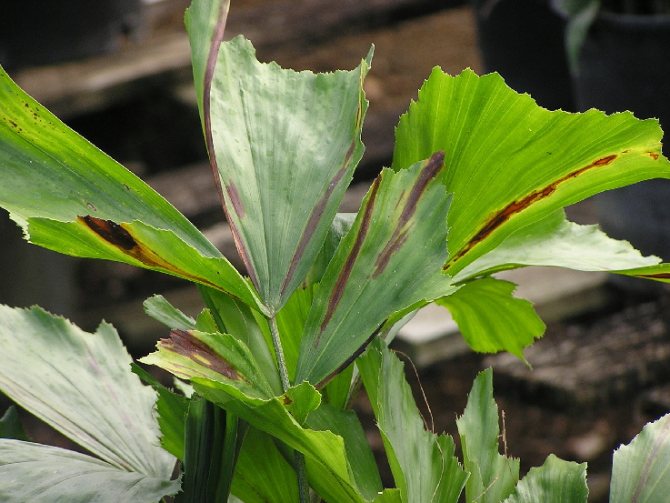

Growing
Cariote is planted in a pot that is suitable in size for both the plant itself and its root system. The transplant of adult specimens is carried out as needed, when the roots fill the entire container and begin to look out of the drainage holes. They are transplanted carefully, using the transshipment method, with the addition of fresh substrate. This procedure is recommended to be carried out no more than once every three to four years with adult plants, and once a year with young ones.
Seed propagation is a difficult undertaking. It should be remembered that seeds quickly lose their germination. Planting is carried out in the spring, in light soil treated with fungicides. The seeds themselves are pre-soaked in one of the stimulating agents. The period before germination is two to four months. The container is placed in a warm, well-lit place (+ 25-30 ° C), covered with foil. The film is removed daily for airing. The pick is carried out after the appearance of the first real leaf.
Reproduction by offspring is possible only for shrub species. The offspring are rooted in the sand at a temperature of + 22-24 ° C, often sprayed, protected from direct sunlight. After rooting, they are transplanted into pots with a diameter of 12 cm.
Features of the reproduction of karyote
Many palm trees reproduce exclusively by seeds, however, vegetative methods are also suitable for karyotes, although only bush ones:
Dividing the palm
The most time consuming method is dividing an adult specimen into separate clumps. Thanks to him, you can get more developed plants in a short time, but the risks of failure are quite high.
You should act carefully so as to damage the root system as little as possible. It is also important to maintain high air humidity during the adaptation of new plants.
Planting cuttings
This method is considered more reliable, but not stem or leaf cuttings are used, but offspring that have their own roots. They are separated, planted in clean sand and covered with a cap.
Planting care is simple - it needs to be ventilated and sprayed every day, protected from direct sun. When the babies are firmly rooted, they can be transplanted into separate pots and groomed like adult palms.
Seed reproduction
Growing a caryote from seeds is not an easy task, since they do not germinate for a long time and, after sitting in the soil for 4 to 12 weeks, may not germinate.
Seed material is sown in March-April, following a certain algorithm:
- A light substrate is prepared and disinfected.
- The seeds are placed in a solution with a growth stimulant for 24 hours.
- Small containers are filled with soil mixture.
- They should be deepened by 10-15 mm.
- The containers are covered with glass or polyethylene.
Before the emergence of shoots, the boxes should stand in the dark, and after they are pecked, they are moved to a place with diffused light. The optimum air temperature for germination is + 25 degrees.
If the plant has the first true leaves, then it is ready to move to a separate small pot.
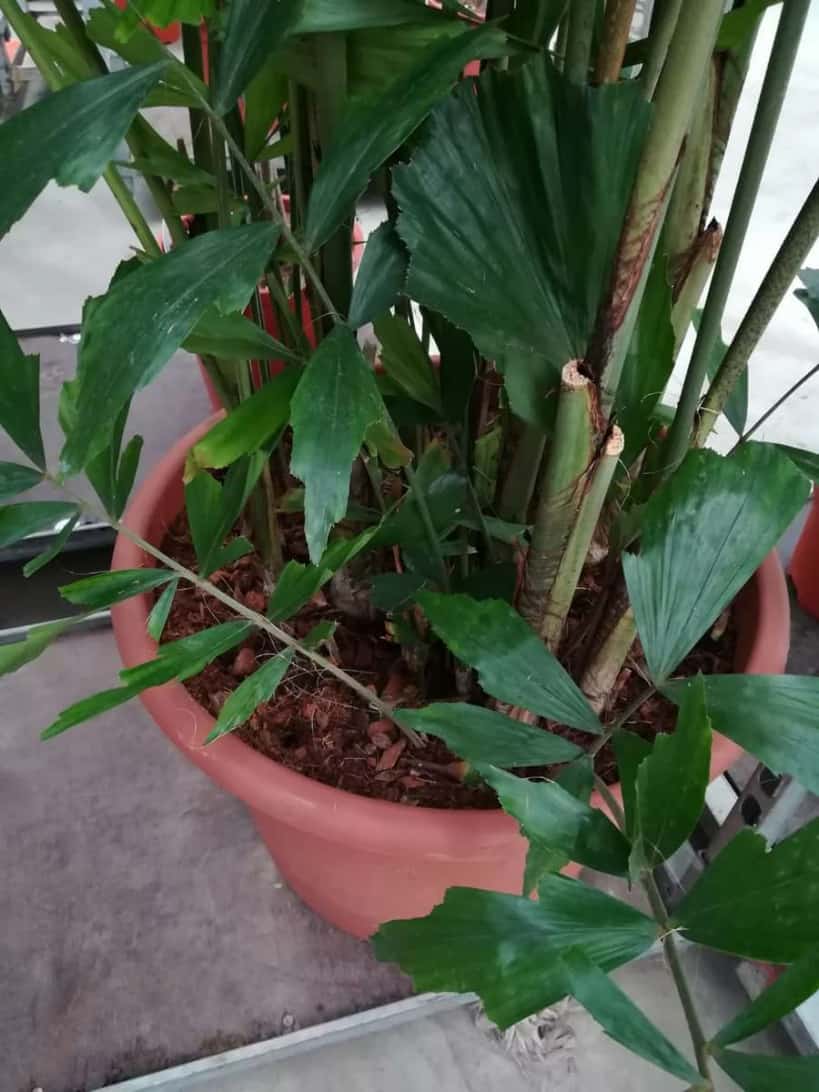

First steps after purchase
Before deciding to buy, inspect the plant: there should be no dots, brown or whitish spots, traces of the presence of pests on the leaves and stems.
The acquired Cariota is carefully transplanted (by transferring) into a suitable substrate. For two to three days, refrain from watering, which can be replaced by spraying.
In winter, it is better not to buy a plant, it will not tolerate transportation well, so it is better to postpone the purchase until the spring-summer season.
Reproduction of karyote at home
Seed reproduction
When purchasing caryote seeds, keep in mind that they quickly lose their germination (at room temperature, the seeds remain viable for up to 90 days). Optimal time for sowing seeds: March / April.
Required materials and tools:
- fresh seeds;
- pots with a volume of 200 ml, according to the number of seeds;
- pre-sterilized soil mixture. The composition of the mixture: 2 parts of leaf humus + 1 part of sod land +1 part of sand (or perlite) + 10% bone meal;
- abrasive stone;
- capacity 0.5l.
1) Presowing seed treatment.
Scarification of seeds: using an abrasive stone, by sawing, we damage the skin of the seed without damaging the kernel.
Soak the seeds in water:
- soaking duration - 2 days;
- water changes daily;
- water temperature 23-25 0 С.
2) Sowing seeds:
- seeds are sown to a depth of 3-4 cm;
- germination period from 20 to 100 days;
- optimum temperature for seed germination: 27 - 30 0 C. Lower temperatures will increase the germination time by 100-200%;
- the potting mix must be kept moist (not wet).
3) Seedling care:
- lighting required for seedlings: partial shade;
- temperature: 21-29 0 С;
- top dressing: once every three months with complex fertilizer 5g / l, with a ratio of N-P-K = 19-6-12.
Vegetative breeding method of karyote
Some varieties of caryotes grow with multiple stems. With stems up to 10cm long, you can separate them. On each "division" there should be a stem that has a root system.
1) Preparation :
- the plant is dug up;
- the earth is shaken off from the roots;
- the rest of the earth from the roots is washed off in water (in a container, or better in running water);
2) Division:
- cut the section of the root collar connecting the two stems;
- the surfaces of the scraps (cuts) are treated with a fungicide;
- We plant the “delenki” as soon as possible at the same depth at which they grew earlier;
- after planting, water the plants.
Compared to other palms, the caryote is not very susceptible to infectious diseases.
Diseases of fungal origin:
1) Helminthosporium leaf spot.
Symptoms: Reddish brown to black spots or streaks that occur throughout the leaf blade. A yellow halo (margin) often surrounds the affected area. Under optimal conditions for the development of the disease, the lesions coalesce and form large, irregularly shaped necrotic areas on the leaf. Sometimes a healthy new leaf can be completely covered with necrotic lesions.
Disease control. The disease practically does not manifest itself on plants that are not sprayed with water. To control the disease, the plant needs the maximum allowable illumination for this type.
2) Root rot and wilting - Fusarium, Rhizoctonia, Pythium and Phytophthora spp. Control methods are described in the "Diseases" section.
3) Sclerotinia rot (Sclerotinia homeocarpa). Seeds and crops are affected.
Leaf care
If splashing water, during watering, contaminated the karyote leaf, then you can clean it with a flannel moistened with a 5% solution of oxalic acid, followed by a warm shower and wiping the leaf dry. Dust should be removed regularly, every two weeks, by wiping the palm leaf with a damp flannel.
The use of chemical cleaners is not advisable - there is a high probability of leaf chlorosis.
Content infringement issues:
1) Weak or absent growth, chlorosis of the leaves, especially the lower ones.
- insufficient illumination of the plant;
- reduced temperature of the content. Palm tree development stops at temperatures below 18 ° C.
2) Chlorosis of young leaves. The reason is lack of nutrients. An increased pH of the soil mixture can cause a deficiency of manganese and iron, which manifests itself in the form of mellitic chlorosis of young leaves. When the situation worsens, chlorotic tissue turns into necrotic spots.
- bring the pH of the soil mixture in line with the recommended;
- carry out foliar dressing.
3) Marginal leaf burn. The reason is that karyota is sensitive to waterlogged or poorly aerated soils. Marginal leaf burn usually occurs in a relatively short time after root damage begins. It is necessary to change the soil substrate (full or partial), at the same time watering is reduced.
4) Chlorosis of the lower leaves appears first. Symptoms develop at the edge of the leaf and progress towards the inside of the leaf. This is a fairly common problem. The reason is magnesium deficiency.
- possibly low temperature of the content;
- carry out foliar feeding with magnesium sulfate;
- root feeding with magnesium sulfate.
5) The tips of the leaves die off, turn brown. The reason is fluoride toxicity. When caring for a palm tree, avoid using fluoride, especially superphosphate.
6) Elliptical spots on leaf feathers that slightly resemble fungal leaf spots. The reason is the toxicity of copper. Avoid using fungicides that contain copper. The concentration of copper used in mixed micronutrient fertilizers is not considered a potential problem when used at recommended rates.
7) Brown spots on the surface of the leaf plate. The reason is boron toxicity. Most likely, there is an overabundance of boron in the irrigation water. To fix the problem, you need to flush the soil with plenty of water.


9) Appearance of yellow or brown spots in summer. The reason is excessive lighting.
10) The palm leaf curls, straw-colored spots appear on the leaf plate. The reason is excessive lighting.
11) The whole plant darkens, signs of decay appear. The reason is frequent watering.
12) The tips of the leaves die off, the older leaves turn yellow. The reason is rare watering.
13) The palm leaf turns light green, the plant stops growing. The reason is nitrogen deficiency.
14) Bronze spots appear on the leaf plate. Symptoms occur primarily on older leaves: they usually appear as translucent yellow or orange spots. Necrosis of the edges appears on the leaves. Later, the leaf dries up and curls. The leaf and veins turn orange.
The reason is potassium deficiency.
15) On new leaves, unexpressed chlorosis occurs. The leaf develops weak, smaller than it should be, and with large necrotic stripes. The reason is manganese deficiency.
Manganese deficiency is primarily caused by the insolubility of the element at high pH or low soil temperatures.
16) Small necrotic spots. The reason is zinc deficiency.
Mealybug, spider mite, scale insect, whitefly, thrips. For pest control methods and techniques, see the Pests section of the site.
Botanical name: Caryota.
Cariota palm - origin ... Burma, Malaysia and the Philippines.
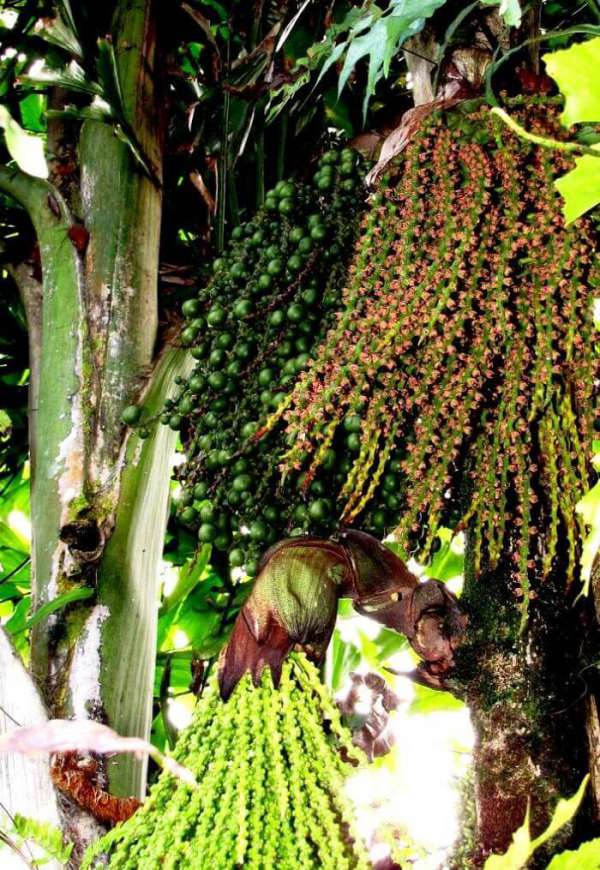

Description ... The genus Cariota or fishtail includes 12 species of palm trees with one or more trunks. Stems are erect, slender, crowned with a lush crown of large, feathery leaves 3 - 5 m long and about 1.5 m wide. Light green leaves have a very unusual angular shape, similar to a fish tail. There are varieties with variegated leaves that have radiant veins of a lighter tone. It is a monocarp plant and blooms only once in a lifetime, but it can last for about 6 years.Inflorescences are large, branchy drooping ears containing large clusters of yellow, greenish or purple flowers. After flowering, spherical, reddish berries appear on the plant. Only adult plants at least 10 years old bloom.
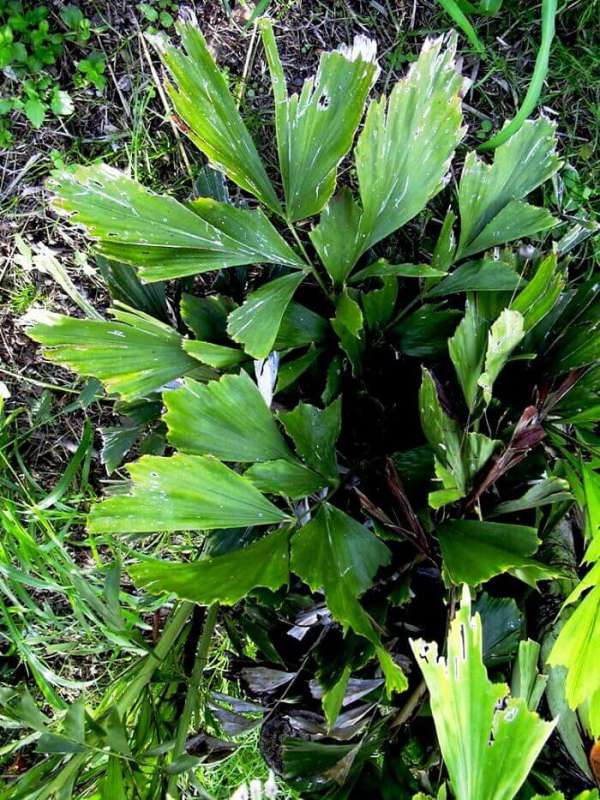

Varieties:
Caryota burning - Caryota urens
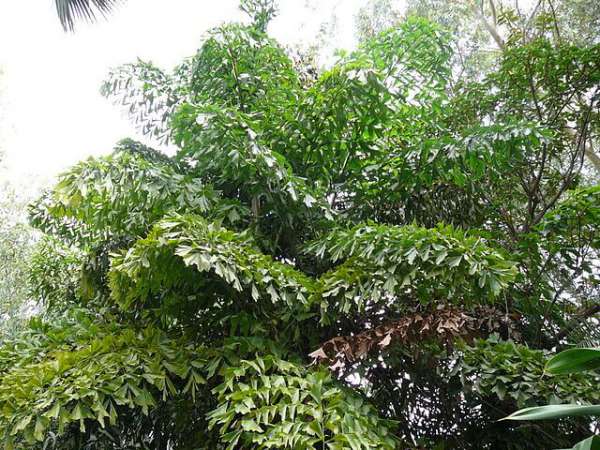

Caryota tender - Caryota mitis
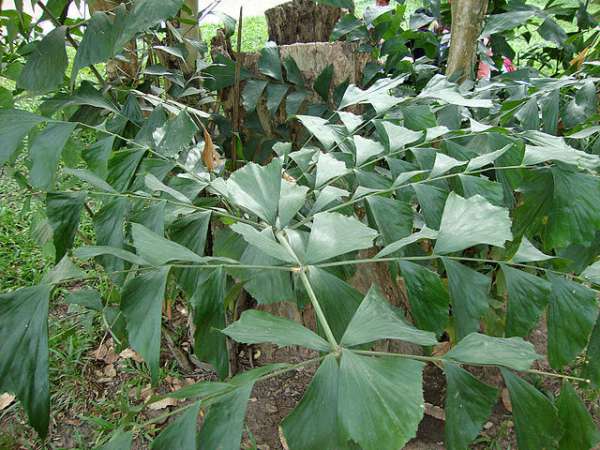

Height ... Over time, the palm tree can reach a height of 2.50 m, however, it has a very slow growth rate and adds only a few centimeters per year. At home, mainly young caryotes are grown as indoor plants.
Success secrets
Kariota is a native of tropical regions. She loves warmth and high humidity, so the air temperature in the warm season should be + 22–24 ° C, and in the cold season it should not drop below + 18 ° C with a constant air humidity of about 60%. These conditions are easy to create in well-heated rooms, and daily spraying will help maintain moisture levels even in dry air. The main rule: the higher the air temperature, the more often you need to spray the plant.
The palm tree prefers abundant watering as the top layer of the soil dries up, but in no case should water stagnation be allowed. The excess drained into the pallet after watering must be removed. Soil for palms of this genus is drained with great care.
The plant needs bright lighting, from October to March, direct sunlight is permissible. But in the summer, from the midday sun, the plant must be shaded.
Complex mineral fertilizers are applied once every two weeks. Top dressing is indispensable for good growth and preservation of the decorative properties of Cariota.
The palm tree loves fresh air, does not feel well in musty, unventilated rooms. However, when ventilating, drafts must be avoided, they can severely damage the plant.
Cariota care
Temperature conditions
... Loves warmth and moisture. In summer, normal room temperature is suitable, in winter in a cool room with a temperature of about 13 ° C. The ideal temperature range is 18 - 29 ° C in summer.
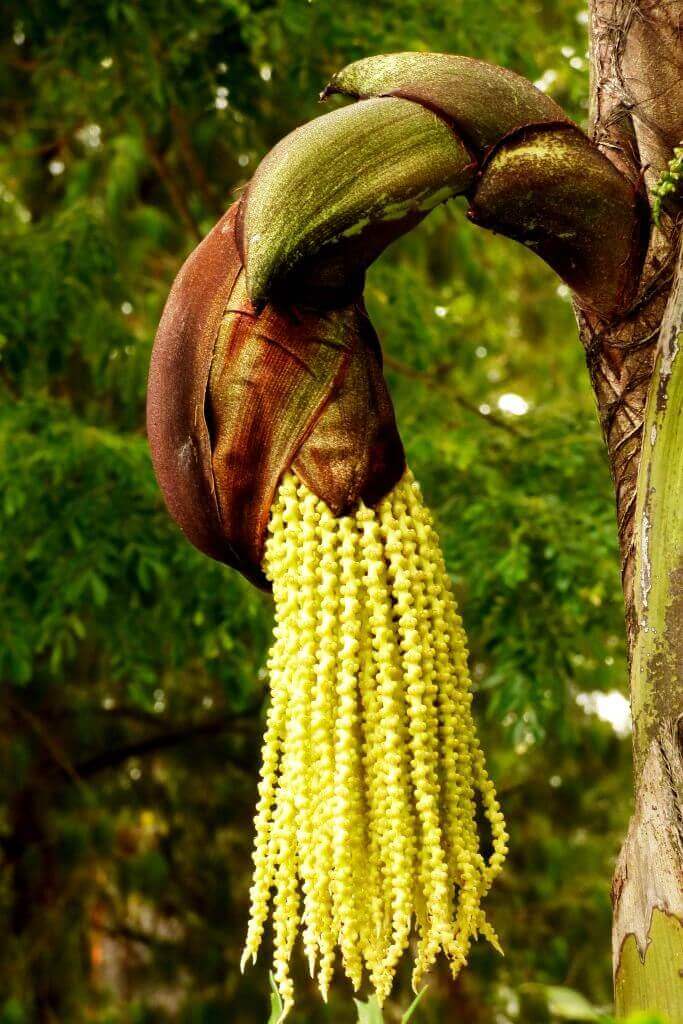

Cariota at home - lighting
... Bright, but reflected light, can grow in partial shade.
Care
... One of the most undemanding palms. Wipe the leaves of the plant with a damp sponge to remove dust. If the growth point of a palm tree is damaged, it stops growth.
Substrate
... Well-drained soil with sufficient content of coarse river sand and neutral or slightly acidic pH. A mixture based on peat with the addition of leaf humus, sphagnum moss, pine bark, fallen needles and small pieces of charcoal is suitable. The substrate must pass water and air well.
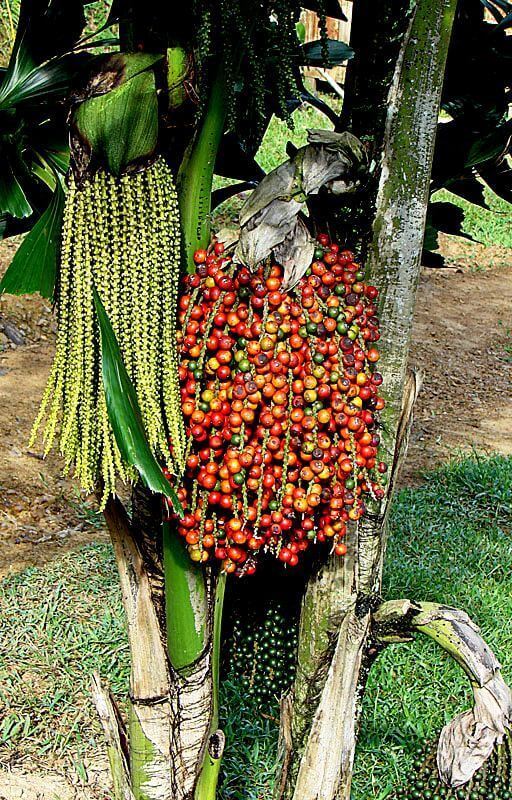

Top dressing
... Regular liquid fertilizer once a month from early spring to mid-autumn.
Appointment
... It is a shade-tolerant palm tree and is easy to grow in shaded areas, so it can be placed in poorly lit areas along with ferns.
Flowering time
... In room culture, it occurs extremely rarely. Even in greenhouses, when the plant is kept in ideal conditions, the flowering of caryotes is a unique phenomenon.
Air humidity
... At least 50%, place the palm tree pot on a pallet of damp pebbles, or use a room humidifier to increase the humidity. It is recommended to spray only with soft water at room temperature.
Soil moisture
... Water abundantly in summer, keeping soil moisture even. Drain excess moisture accumulated in the pan after watering. In winter, the topsoil should dry out between waterings. Cariota is more tolerant of drought than waterlogging. Like other types of palms, karyota should be watered with soft water, as it does not tolerate the high content of fluoride, chlorine and other chemicals in the water.
Caryota palm (Latin name Caryota) belongs to the Arecaceae (Palm) family, which has about 20 species.In nature, these species are capable of cross-pollination, which makes it difficult to classify them. Another name for the plant is "walnut palm" ("karyota" in Greek - nut). These evergreen, ornamental foliage plants are presented in various forms - these are giant plants with a single trunk up to 25 meters high, for example, Cariota burning, or Wine palm (Caryota urens) and small bushy plants that form dense thickets - Cariota soft (tender), or Fishtail palm (Caryota mitis).
A distinctive feature of this type of palm is the original structure of the leaf blade. Its leaves are complexly dissected, doubly pinnate, in other words, there are petioles on the leaf petiole, on which the leaf blades are located. This leaf structure is very rare and unique in the case of palm trees. The leaf blades of different karyote forms differ from each other, but the double-peristose complexity is preserved in all cases. And the leaves of Cariota are so original that they are torn off at the edges and resemble the structure of a fish fin in shape, which is reflected in the name of the palm - Fishtail palm.
Kariota is also interesting because it refers to once flowering plants. Flowering occurs at the age of 10 - 15 years and lasts 5 - 7 years continuously. At first, the peduncles bloom in the axils of the upper leaves. Then flowering continues, dropping lower. After the last fruits ripen, the plant dies off. If it has one trunk, like the Wine Palm, this leads to its death. Bush forms of karyota, having lost a faded shoot, are renewed at the expense of offspring.
The caryote palm is quite capable of tolerating room conditions. Although its origin from tropical regions (range from Eastern India to Australia) dictates its own conditions of detention. This large plant requires ample space. It can develop well in a living room (small specimens), but it feels better in a conservatory or greenhouse.
Possible difficulties
Leaves droop down, droop
Reason: 1) lack of watering.
The ends of the leaves dry up
Reason: 1) not enough humid air.
The foliage darkens, withers
Reason: 1) cold air and drafts.
Cariota palm fishtail
- one of the brightest representatives of the family, which includes many palm trees. She received her popular nickname for the very obvious resemblance of leaves to the equally important dignity of fish.
In general, to acquire such a plant it is necessary to have a great love for plants and appropriate conditions for a "walnut palm" or "fishtail palm".
Pests of cariota
Pests of cariota are standard for all types of palm trees. In indoor conditions, it can be affected by a spider mite, scale insect, scale insect. When the soil is waterlogged, infection with mushroom mosquitoes is observed. To prevent critical situations, it is necessary to regularly inspect the plants, to carry out treatments with insecticides (for example, Fitoverm) and fungicides (Topaz) on time. Observe correct agricultural practices and do not forget about the hygienic measures mentioned above. Young plants can be immersed in a green soap solution with leafy plates, followed by rinsing in the shower.
Compliance with the suggested recommendations will guarantee a long healthy life for your green pet.
Family: Arecaceae.
Homeland: India, Madagascar, Tropical Asia, Oceania islands.
Flowering: does not bloom in indoor culture.
Common species: Caryota monostachya (one-spiked caryote), Caryota no, Caryota ochlandra, Caryota rumphiana (Rumph caryote), Caryota urens (pungent caryote or wine palm)
Optimum illumination: diffused sunlight.
Permitted lighting: partial shade.
Direct sunlight is allowed:
- in the period October / March - no restrictions;
- in the period April / September - from 11-00 to 15-00 it is necessary to provide shading from direct sunlight.
In order for the plant to maintain symmetry, every two weeks, it is recommended to rotate it around its axis by 180 degrees.
Temperature
The optimum temperature is 21-29 0 С.
The average temperature of winter maintenance is not lower than 18 0 C.
An adult karyote with a trunk can withstand a short-term drop in temperature to -6 0 C. Leaves tolerate a short-term temperature drop to 0 0 C without damage.
A prolonged decrease in temperature to 0 0 C will seriously damage or even destroy the plant.
The caryote will withstand the temperature of 13-18 0 C without damage for two weeks.
Air humidity
Optimum humidity is high / moderate. Drafts (cold or hot air currents) cause damage to the leaves, reducing the decorative effect of the palm.
Spraying karyota in cold cloudy weather is strictly prohibited.
The optimal frequency of watering is with light drying of the earthy coma between waterings. After watering, do not let the plant sit in the water. Excess water from the saucer must be removed immediately.
Cariota is sensitive to water hardness. For irrigation, you must use settled rainwater or purified (bottled), condensate from an air conditioner is also suitable. When using tap water for irrigation, it should settle for at least a day, because palm is sensitive to chlorine.
Cariota is one of those palms that tolerate insufficient watering better than frequent watering.
The optimum acidity of the soil mixture: acidic or neutral pH 5.6-7.5. Basic requirements for the potting mix:
- must ensure quick drainage of water;
- must retain its structure for a long time.
The composition of the soil mixture for growing karyote: 2 parts of pine bark (fraction of at least 20mm) + 1 part of crushed dolomite or pebbles (fraction 12mm) + 2 parts of coarse peat + 1 part of charcoal (fraction of at least 10mm) + 1 part of perlite (coarse fraction) + 0.1 parts of bone meal.
In alkaline soils, with a pH above 7.5, many trace elements become inaccessible to the plant.
Planting / transplanting karyotes
The optimal period for transplanting is April. A transplant in the classic version, with the destruction of an earthen coma, is not recommended for adult palms. Cariote, like all palms, is recommended to be transplanted / reloaded while maintaining an earthen coma, when the roots fill the entire pot.
Transfer frequency - as needed:
- if the substrate has deteriorated;
- if the plant has grown in size and the pot needs to be increased.
When transplanting, part of the roots that form the felt layer are cut off with a sharp knife so that the plant fits in a new pot.
Attention: when transplanting / transshipment, it is absolutely impossible to bury the palm tree. After transplanting, the soil level marked on the trunk of the palm tree should match the soil level before transplanting.
When planting a plant, choose the size of the pot correctly - it is unacceptable to plant a small plant in a large pot, this mistake of flower growers is one of the most common.
Top dressing is carried out from April to August with fertilizer for indoor plants (palms). The frequency of feeding is once every two weeks. The optimal ratio of nutrients in the fertilizer N-P-K = 9-3-6. Every month, during the growing season, we carry out foliar feeding with microelements.
At ambient temperatures below 18 0 C, many nutrients cease to be absorbed by the roots of the palm tree.
Pruning cariota
- green leaves;
- leaves that have partially changed their color to yellow or brown. Cause - a palm tree draws out nutrients from dying leaves.
When pruning, be careful not to damage the trunk of the palm tree. Never remove more leaves during a year than there are in a year. If the number of new leaves is less than the number of dead leaves, the palm tree has a problem.
Botanical description
Karyota
(lat. Caryota) belongs to the palm family (lat. Palmae). This is a fairly fast growing palm tree.
Trunk
grows up to 5 m tall, drooping flower panicles form on it. The first comes out of its top, and the following from the axils of living or dried leaves.
Flowering can
last for several years, without resting the plant. After flowering, the entire plant dies off. At the same time, offspring are formed, which enable the karyote to renew itself.
Caryote leaves
- double-pinnately-divided, wedge-shaped leaflets, cut from above, unevenly toothed. This characteristic of the appearance of the leaves makes them resemble the fins of a fish. Therefore, the karyote is called "fishtail palm".
Possible growing problems
- If the plant begins to lose its decorative effect, gets sick, then the most common reason is a lack of light. Also make sure that there is no waterlogging of the soil.
- If some nutrients are deficient, such as iron, magnesium and manganese, yellow spots may form on the leaves. Always use complex fertilizers with a set of trace elements, additionally feed with iron chelate and magnesium sulfate.
- Cariotes are not particularly susceptible to fungal diseases, but if a mushroom-like brown spot appears on the leaves, treat it with a fungicide.
- With poor ventilation, dry air, lack of lighting, the karyote can be affected by spider mites. Wash the plant regularly with a warm shower and keep it in optimal conditions.
- Palm trees are also susceptible to attack by mealybugs, whiteflies, aphids, scale insects.
On control measures - in the article
Karyota soft, or karyota mitis, is an elegant palm tree that is very popular with flower growers. It belongs to the Agesaseae family and comes from India and Malaysia.
- Latin name: Caryota mitis
- Family: Arecaceae
- Growing up: easy
- Location: illuminated, tolerates exposure to direct sunlight
- Temperature: not lower than 12 0 С
- Bloom: in spring
- Watering: sparse in winter, regular in summer
- Homeland: Asia
- Height: 2.5 m
- Transplant: every 2-3 years
- Care: polishing the leaves with a damp cloth
For the appearance of the leaves, resembling the fins of a fish, it was nicknamed "fishtail palm". In nature, its height can reach 16-18 m, but when grown indoors - no more than 2.5 m. Caryote stems are erect, with bright green wedge-shaped, double-dissected leaves with a serrated edge. Flowers develop into branched inflorescences in spring. The fruits are round and pinkish.
On a note
Soft cariota can be purchased at garden centers and specialized stores. Choosing an already mature plant, you can count on its good adaptability and developed root system.
Caring for cariota is easy. For harmonious growth, it needs a loose soil that provides good drainage. Ideally, it should consist of peat, potting soil, a few handfuls of organic matter such as compost, pumice or expanded clay. You need to fertilize the plant only during the growing period - from April to September, about once a month, using a balanced liquid fertilizer dissolved in water for irrigation. Leaves can be polished with a damp cloth using a special leaf polish (preferably natural).
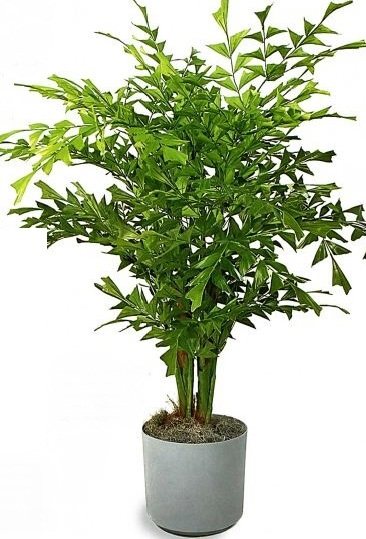

Location
Cariota soft loves diffused light, but it also tolerates direct sunlight well. Therefore, it can be placed near well-lit windows, and in the height of summer, it can be taken out.
Temperature
Kariota is afraid of drafts and cold temperatures below 12 ° C. High temperatures are not dangerous for her.
Watering
In the spring and summer, the karyote is regularly watered, keeping the substrate constantly moist. In autumn and winter, watering is reduced to almost nothing.
Transfer
This plant is transplanted every 2-3 years as it grows, choosing a pot slightly larger than the previous one. A layer of drainage material should be placed at the bottom of the pot, and more organic fertilizer, such as compost or matured manure (preferably in powder form), should be added to the soil mixture.
Reproduction
Cariote is best propagated by seed, which is placed in pots filled with a suitable potting mix. Maintain substrate moisture and temperature around 22-24 ° C and sprouts will appear within a few weeks. When they are old enough, they can be transplanted into larger pots and looked after as if they were mature plants.
Karyote species
For indoor floriculture and home care, these types of karyotes are suitable.
Karyota offspring
(lat.Caryota sobolifera, Caryota mitis). A distinctive feature is the leaves, which have an oblique incision on top, of a deep-toothed shape.
Burning cariota
(lat.Caryota urens). The plant is less lush than representatives of the genus. The leaves are unevenly toothed at the top, have a more regular triangular shape.
Kariota Rumphia
(lat.Caryota Rumphiana). Of all the species, it has the most luxurious growth of green mass. The leaves are similar in shape and structure to pungent caryote.
Types of home decorative palms
The following common species are grown as home decorative specimens.
Caryota urens
... The name was given because of the high content of oxalic acid salts in the fruits. It is sometimes called the wine palm. The plant can be attributed to greenhouse and greenhouse rather than indoor. In the regions of initial growth, the trunk is used for construction purposes; after industrial processing, cereals (sago), wine and sugar are obtained from the core. The main difference is the leaves in the form of triangles. The maximum height is 2.5m.
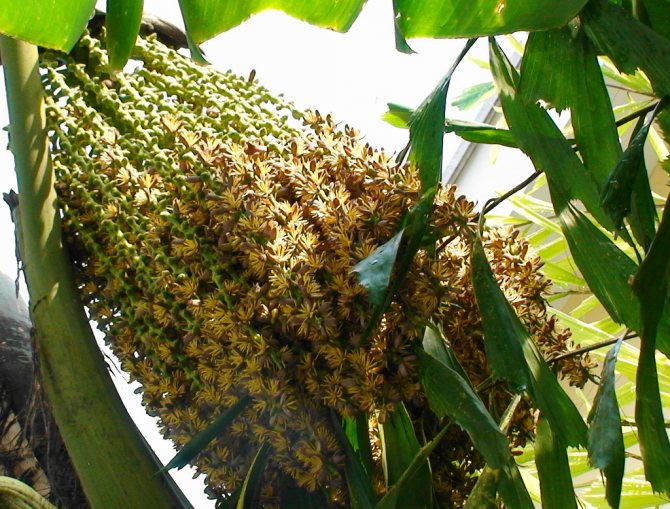

Caryota gigas
... A distinctive feature is its large size, it can reach 15 meters in height and have a trunk diameter of up to 75 cm. It is grown because of the beautiful decorative leaves, which have a fan-shaped shape and wavy edges. The petioles of the leaves are black, giving the corresponding color to the trunk of the palm tree.
Soft or tender cariota (Caryota mitis)
, there is another name - the fishtail palm because of the leaves torn off at the edges, very reminiscent of the tail of sea creatures in their shape. The maximum growth of an ornamental plant is 1.5m, in nature - 10m. The volume is formed by the leaves of the top, on the trunk - only old, dry leaves. A young palm tree forms many root suckers and a dense bush, more like a shrub than a tree.
At home, the fishtail palm is considered the best option.
Humidity and watering
Humidity
air for karyota is of great importance, this figure should be kept within 70%.
To meet this condition, you can carry out daily spraying or wipe the leaves of the plant with a damp cloth.
Water the cariota
costs regularly and abundantly. In the summer, it is necessary to monitor the constant soil moisture.
In winter
watering is reduced, but carried out as regularly as in summer. Water is used soft and warm. If possible - warmed up, thawed.
About caring for Cariota:
Temperature:
The optimum temperature for Cariota in summer is 18-22 ºC, preferably no higher than 24 ºC. On especially hot days, it is recommended to protect Kariote from overheating, transfer to cool places. In winter, the temperature should not drop below 13 ºC, but if the winter is not very cold, then Kariota can be left on the balcony in an insulated pot, in foam rubber or in a bucket of sawdust to a minimum temperature of -3 ºC. If the palm tree hibernates, nevertheless, in room conditions, it must be often sprayed and not placed next to the heating device. Ideally, Cariota would still prefer to stay on the balcony in summer and winter.
Lighting:
Kariota loves diffused lighting and is not particularly shade-tolerant. When shaded, growth may slow down and the decorative effect of the plant may be lost. Therefore, western and eastern windows are preferred. The plant must be protected from direct sunlight and heat, otherwise the leaves may get burned.In winter, the lighting should be very good, if necessary, use a fluorescent lamp. Cariota does not like overheating of the roots, so it is advisable that it be placed on the floor or on a special stand so that the lighting falls from above onto the foliage, but this requirement is not too necessary.
Watering:
Cariota needs regular and moderate watering. Watering is necessary with soft, settled water. The frequency of watering depends on the temperature of the content. When watering, you should focus on the drying out of the earthy coma, the earth should have time to completely dry out. It is recommended to drain excess water from the pallet. In summer, the palm tree has active growth and an increased need for water, since the soil dries out faster. In winter, when kept cool (5-15 ºC), watering is shortened and extended dry periods. The lower the temperature of the content, the longer the palm must remain dry.
Air humidity:
Cariota is a very moisture-loving plant and spraying is an obligatory part of caring for it throughout the summer, especially when the air humidity is below 50%. In winter, if the indoor air is dry, it is necessary to spray regularly or install a humidifier. For spraying, the water must be settled or rainwater. To increase humidity, you can place a container with water next to the plants.
Fertilizers
: It is necessary to fertilize during the period of active growth, from spring to autumn, once a week. In winter and autumn, all feeding is stopped. For feeding, you can use complex fertilizers for decorative deciduous plants, as well as special fertilizers for palms. You can partially fertilize by spraying the leaves, but with a very weak solution.
The soil:
For palm trees. Good drainage is essential. It is recommended to add perlite, vermiculite, charcoal to the substrate.
Transfer:
It is necessary to transplant Kariote as it grows, when the roots fill the entire pot and begin to crawl out. Roughly young plants are transplanted every 2-3 years. The palm tree does not really like transplanting, therefore, the transshipment method is used with the complete preservation of the earthen coma in order to avoid root injuries. It is not recommended to ram the earth, it will settle itself after watering and then it will be possible to fill up with new one. In adult plants, if a transplant is not needed annually, it is necessary to change the topsoil. Good drainage is essential. The pot for Cariota is selected high and not very wide, since the palm tree has deep roots that require access to free soil.
Cariotes.
It can be amazed and (they start when there is a lack of moisture) and. For prevention, it is necessary to use a warm shower, wipe the leaves. With waterlogging, it can be affected by mushroom mosquitoes.
Plant varieties
At home, there are two types of palm trees. The rest mainly grow in their natural environment.
Soft caryote
Cariota with several trunks, growing at home up to one and a half meters, but continues to expand to the sides. In nature, it can stretch up to nine meters. When dividing from the mother palm, several new ones are obtained. The leaves are in the form of triangular wedges with a jagged edge.
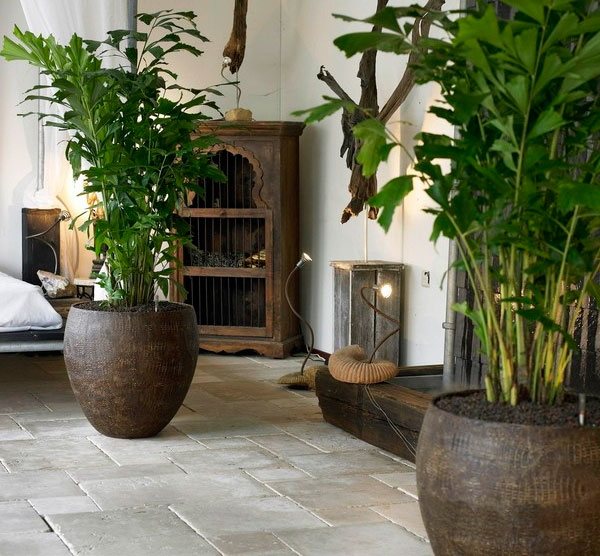

Wine palm
The wine caryote has one trunk, framed by triangular foliage. In their natural environment, inflorescences grow up to several meters. This type of palm has large red fruits.
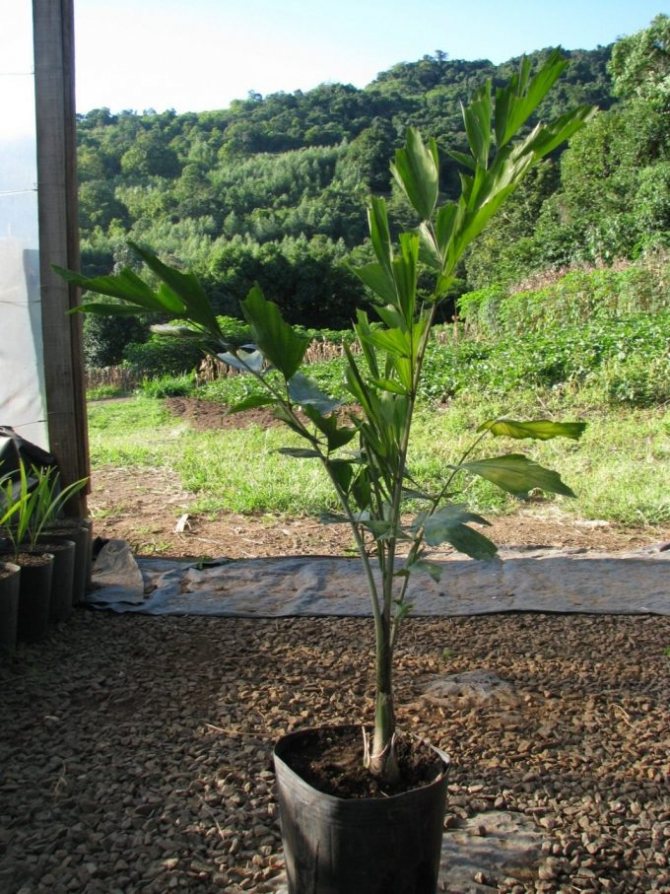

How is the transplant carried out
Any soil designed for palm trees or other indoor flowers is suitable for transplanting. If the caryote is kept at a comfortable temperature, without drafts and with an optimal irrigation regime, then almost any land is suitable for growing.
An important prerequisite for the rapid growth of a palm tree is the correct pot. Plants can be transplanted into a container, provided that their height is greater than their width. The root system of a palm tree is strong and core, which needs a lot of soil.When replanting, the new pot increases by five centimeters compared to the old one.
The transplant procedure is done only if necessary. A young plant needs to be replanted every couple of years. Older palms need to be replanted no more than once every three years.
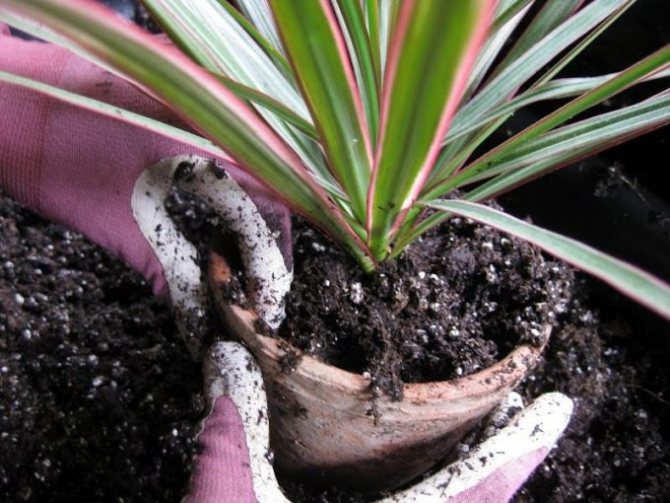

Transfer to a new container must be carried out with an old earthen clod. If you wish, you can remove the top layer of soil in the pot. The transplant is done carefully because trauma to the root system can lead to the death of the karyote. At the bottom of the pot, a drainage layer is laid out, consisting of expanded clay or pebbles.
Palm propagation process
Caryote palm fishtail propagates with the help of seeds and layering. Layers can be planted when they begin to root. At this time, they are separated from the mother plant. The resulting processes quickly take root if roots have already appeared on them.
Layers are pulled out of the ground and removed from the sun's rays and moistened by spraying from a spray bottle. This procedure contributes to the rapid formation of the root system. They are planted in a sand pot. At first, a young plant needs greenhouse conditions.
If you decide to get karyote by planting seeds, then the procedure takes time and patience. Germination lasts 30 to 90 days. It all depends on the germination of the planting material and its quality. It is also important how the seeds were stored. The soil must be disinfected before planting seeds. To do this, it is watered with a fungicidal solution. Pre-planting material is soaked for 24 hours by adding a biostimulator to the water.
Popular: Six beautiful inflorescences of varieties and types of chestnut tree
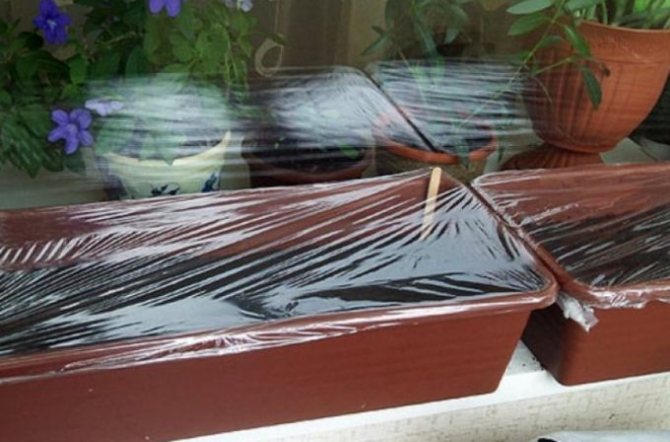

Palm seeds are deepened by no more than a couple of centimeters. The height of the container should not be 10-15 cm. The container is covered with a film, making a greenhouse, and put away in a dark, warm place. The temperature for germination must be at least 25 degrees. From time to time, the glass is raised and the seedlings are examined, aired.
After the seeds sprout, the film is removed, and the container with the sprouts is transferred to a room with diffused sunlight. After the first leaf appears on the seedlings, they are seated in small individual containers.
What the palm tree is sick with
The plant is resistant to infectious lesions, but the high humidity that the plant needs can cause fungus. With a fungal infection, the leaves are covered with spots, a yellow border appears along the edges of the leaf plate. With a progressive fungal infection, the areas merge and turn into necrotic "islets".
At this time, you cannot spray the palm tree, since the remaining drops on the leaf plates and heat provoke the rapid development of a fungal infection. This leads to more severe infection. To eliminate the fungus, the palm tree, on the contrary, is exposed to the sun's rays. Care should be taken that its delicate leaves do not get sunburn. A spider mite can damage a karyote, less often it is affected by a whitefly or mealybug. Cariota can also become infected with scale insects. Spraying with insecticides will help cure the palm tree. It is possible to destroy pests using folk methods.
Now read:
- The main technologies for growing peas and caring for them
- Seven types of Phoenix palm trees for home and greenhouse cultivation
- Planting to decorate the site with three types of conifers
- Improving and restoring compost with EM-preparation
About
Leading Researcher of the Laboratory of Vegetable and Berry Crops, Yakutsk Research Institute of Agriculture, Siberian Branch of the Russian Academy of Agricultural Sciences, Republic of Sakha (Yakutia).
A little about the caryote plant
Visually, this type of palm tree can be distinguished by its decorative leaves with ragged edges, which have an original shape.
In the genus of plants, scientists have more than 10 species. The homeland of the palm tree is considered the countries of Asia, India, Indochina.Here wine is made from the plant and sugar is isolated from them. In nature, a palm tree can grow over ten meters. The most common type that can be seen in greenhouses is called tender calorie.
The palm tree stretches quickly even when indoors, but here it is much lower. In a maximum of several years, the plant grows up to two and a half meters. In this case, the owner, if desired, can slow down its growth. Therefore, the transplant procedure is carried out only when the roots have filled the entire pot.
In nature, different types of palm trees can look like a tree or shrubs forming thickets. Their leaves are thick, feathery and similar to the tail of a fish. Like any child of a tropical climate, the cariota prefers humid air and warmth.
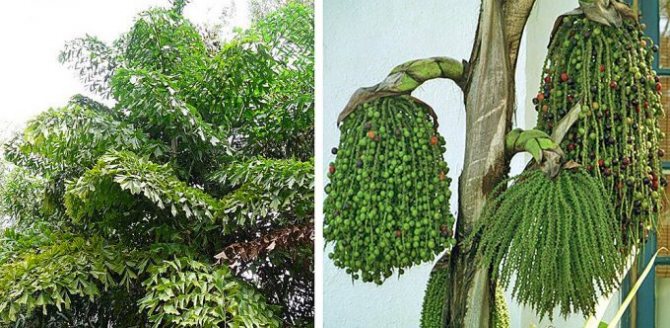

The caryote palm will probably not bloom in an apartment or home greenhouse, even experienced botanists in scientific gardens can very rarely achieve the formation of buds. Under natural conditions, the caryote blooms in the tenth year, flowering does not stop for five to seven years. But for this it must grow in tropical climates.
The cobs can be compared to the large tails of a horse. The inflorescences are hidden in the leaf axil. Flowering begins from the top of the plant, gradually capturing the lower branches. The same thing happens with fruits. They first appear at the top of the plant, then at the bottom of the palm tree. They contain needle crystals that can injure the skin upon contact.
After the caryote has finished bearing fruit, the trunk of the plant dies off. Palm trees with a tree trunk die completely, and those varieties that are shrubs are restored due to cuttings near the roots.
Popular: Decoration of a decorative landscape with a small-flowered pine tree
Reproduction, possible difficulties
Karyote propagates by seeds and vegetatively. Unfortunately, seeds lose their germination after 2-3 months of storage, so this method is not the best. But, as already mentioned, the fishtail karyote can be easily propagated by dividing the bush.
Cariota is a young plant
Already with a shoot length of about 10 cm, it can be detached. You still need to act very carefully, since palms are very painful to any violation of the root system.
In dry room air, a tick loves to settle on a caryote. It is better to deal with it with herbal remedies: soapy water, tobacco dust. Compared to other palms, cariota is less susceptible to disease.
About 12 species of plants of the Arekov family belong to the genus Caryota L. It grows in tropical Asia, the Malay Archipelago, the islands of Java, the Philippines, New Guinea, and tropical Australia. A very peculiar group of palms, unlike any other genus. The only one of all, which has intricately dissected double-pinnate leaves with an unusual shape of feathers - asymmetric oblique-wedge-shaped, with a truncated, unevenly "gouged" top, strikingly similar to a fish fin, for which the plant is called "fishtail palm" (Fishtail -Palm).
Representatives of the genus Cariota are single and multi-stemmed trees. Monoecious plants; flowers are unisexual, sessile, between two male flowers - one female with sterile stamens. The inflorescence is a branched ear. The flowering of the karyote is quite unusual. Its large axillary inflorescences of numerous drooping twigs, similar to a clipped horse's tail, develop in the direction from the top of the crown to its base. The tree blooms continuously for 5-7 years. The lowest inflorescences bloom last, when the fruits are already ripe in the upper ones. After the lowest fruits ripen, the trunk dies, and in single-barreled species the entire plant dies. The average life span of a karyote is no more than 20 years.
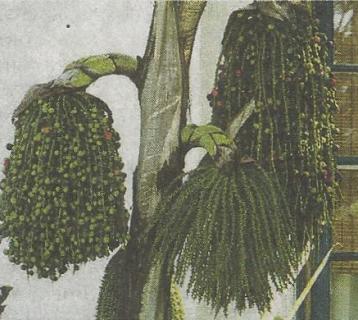

Karyota species are cultivated in many countries with tropical and subtropical climates as valuable ornamental trees.Young, slowly growing pot and tub specimens of karyotes can serve as an excellent decoration for any interior, but, unfortunately, they suffer from the dry dusty air of the premises, nevertheless, with proper care, they can be grown indoors. The species of the genus Cariota are very similar to each other. In culture, two types are most widespread. On sale usually there is a soft caryote (translated from Latin - tender), less often - a burning caryote.
Soft caryota (Caryota mitis Lour.). Grows in tropical rainforests in East India, in the south of the Indochina Peninsula, in the Malay Archipelago. Trees with multiple trunks. The trunk is up to 7-9 m in height and 10-12 cm in diameter. Leaves are double-pinnate, 1.5-2.5 m long, with segments resembling a fish tail. The stem of the inflorescence is 30-60 cm long. The fruit is round, 1.2 cm in diameter, red. Although each trunk of a plant blooms and bears fruit only once and, having fulfilled its function, dies off, the tree as a whole lives for a long time, since more and more young offspring are formed to replace each dead trunk.
Burning Caryota, or Wine palm, or Kitul-palm (Caryota urens Li). Lives in tropical rainforests, on the slopes of mountains at an altitude of 1500 m above sea level in Eastern India, Burma, Thailand, on the Malay Archipelago. Single-stemmed trees, 9-15 m tall and 30-45 cm in diameter. Leaves are double-pinnate, 5-6 m long with green wedge-shaped stipules 25 cm long. Cream flowers. The inflorescence is large, multi-flowered, hanging. The axis of the inflorescence is 3-4 m long. The fruit is round, 1-2 cm in diameter, red. Flowering occurs at the end of the tree's life. Monocarpous species - dies when the fruits of the lowest panicle are ripe. Flowering begins at the age of 12-15 years and lasts 5-7 years, so its life expectancy is limited to 20-25 years. The plant owes its specific name to fruits, the juicy pulp of which contains calcium oxalate crystals, which irritate the skin. These fruits are inedible, although birds and other animals eat them. But many other parts of this palm tree find the most versatile applications. When trimmed, the inflorescences of karyota secrete sweet juice, from which palm sugar is obtained, and when fermented, wine and vodka "Toddy". The core of the stem of older plants yields edible sago, and the sheaths of the leaf petioles provide the source of the strong fiber known as kitul. It is used to make paper, brushes, baskets, fishing tackle, ropes, ropes. The fiber is so strong that wild elephants are tied with ropes made of it.
Caryota rumphiana. Homeland - Australia and Southeast Asia. Powerful straight trunk up to 18 m tall. Leaves are doubly pinnate, 4 m long, with stipules dissected at the ends. The flowers are purple and yellowish green in long bunches 3 m long. Bluish berries.
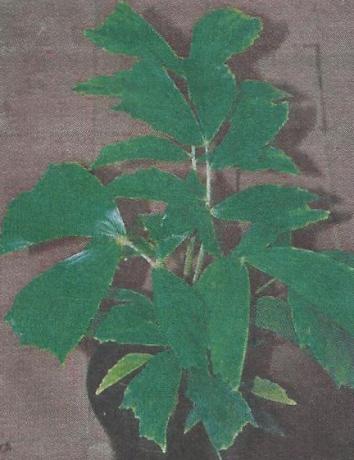

With good care, karyote grows rather quickly in room conditions. For several years, it can grow up to 2-2.5 m. Kariota prefers bright diffused light, suitable for growing near windows of the western and eastern directions. At the windows of the southern direction, the plant should be shaded from direct sunlight in the summer, and at the northern window the plant may not have enough light for normal life. The optimum temperature for karyotes in the spring-summer period is 22-24 ° С, in the autumn-winter period it should not drop below 18 ° С for a long time. But remember, the higher the temperature in the room, the higher the humidity should be. Cariotes need abundant watering from spring to autumn with soft, settled water, as the upper layer of the substrate dries, without stagnating water in a pot or pan. Since autumn, watering is somewhat reduced, in winter watering is moderate. Cariotes need high air humidity, it is recommended to regularly spray them with soft, settled water, especially in the summer heat in an apartment, several times during the day.Top dressing of karyotes is carried out during the active growing season (from spring to autumn) once every two weeks, with liquid complex fertilizer or special fertilizer for palms. He really does not like transplanting, therefore, they are transplanted only when the roots fill the entire pot and begin to crawl out of the container. It is advisable to transplant, or better transshipment, for adult plants once every 3-4 years in the spring. Young plants are carefully reloaded every spring.
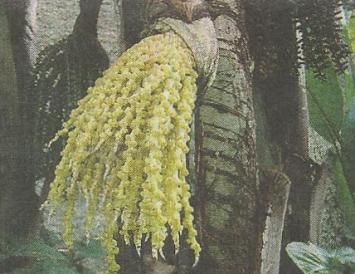

Every year, the top (2-4 cm) soil layer must be replaced with a new, nutritious one. Karyotes are undemanding to the composition of the earthen mixture; it can be slightly acidic or neutral. You can mix turf, compost, humus and sand in equal proportions and add 1 tablespoon of superphosphate for every 3 liters of the mixture. Ready mix for palm trees is also suitable. Good drainage is a must. Propagated by offspring that appear at the root collar. The offspring root well in the sand in the greenhouse at a temperature of 20-22 ° C. Plants are often sprayed and protected from direct sunlight before rooting. During the first year, caring for young plants is reduced to watering. In the spring they are transferred into 9-centimeter pots in an earthen mixture consisting of turf - 2 hours, humus and leaf - 1 hour, sand - 0.5 hours. Cariotes also propagate by seeds. Seeds are sown in February-March, with lower heating they germinate within 2-4 months. Possible difficulties: a palm tree bought in winter, when placed in room conditions, can hurt and lose leaves, it is better to acquire it in spring and summer, if there is insufficient watering, the leaves of the palm tree go down, if the air is too dry, the tips of the leaves become dry, if the temperature is too low and in drafts, the leaves darken and wither. Frequent pests of this type of palm are scale insects, spider mites and mealybugs.
L. A. Palchikova
, laboratory assistant-researcher of NIISS them. M. A. Lisavenko
At home, the karyote is placed in a bright place, but not in direct sunlight. In winter, it is desirable to provide the plant with additional artificial (LED or fluorescent) light. Cariota tender tolerates low light well, therefore it is willingly used for decoration of office premises.
The optimum temperature for karyota in summer is about + 22 + 25 o C, in winter it is desirable a little cooler, but not lower than +16 o C. During the heat, frequent spraying of leaves and good ventilation of the room are required.
Watering in the summer is regular and fairly abundant, but without stagnation in the pot, the soil should be very well drained. In winter, watering is reduced, but not brought to complete drying of the soil.
Karyotes are fed with fertilizer for palms, for decorative deciduous plants, or universal, but only in spring and summer. If leaf spot occurs in karyote, additional addition of iron (in chelated form) and magnesium (magnesium sulfate) may be required. It is advisable to use complex fertilizers with a full set of trace elements.
Palm trees are transplanted as the volume of the pot is filled with roots and new shoots: young plants - every spring, large specimens - once every few years, or are limited to replacing the top layer of soil. For this, a ready-made palm substrate is suitable, in which it is desirable to add perlite or small bark for better drainage throughout the volume.
Overcoming the challenges of growing karyote
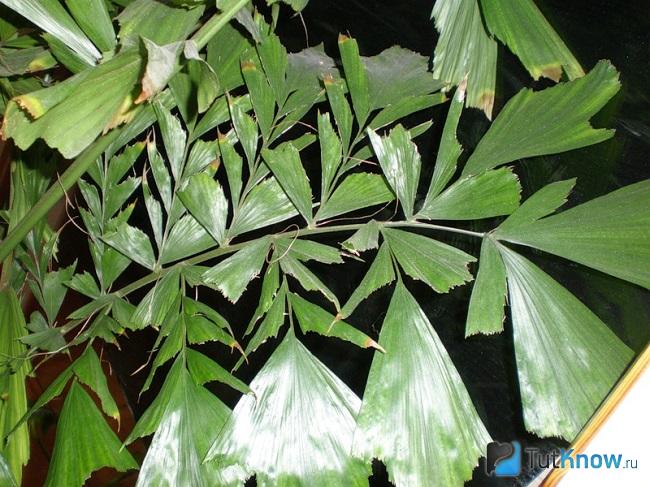

If the conditions of detention are violated, the fishtail palm may be affected by spider mites, mealybugs, scale insects or aphids. For a start, you can wash the karyota under shower jets at room temperature, then process the leaf lobes with soap, oil or alcohol solutions, and if sparing agents do not bring a tangible result, it is recommended to spray the plant with insecticides of a wide spectrum of action.
Also, due to the bay of the substrate, the palm tree can be affected by various rot and some wilting, as well as become infected with late blight and fusarium. The affected areas of karyota must be cut and destroyed, and then treated with fungicides.
If watering is not enough for the palm tree, then its leaves will begin to fall down and with low humidity in the room, this threatens to dry out the ends of the leaf lobes, and when the temperature drops and drafts, the leaves will begin to darken and fade.
Growing difficulties
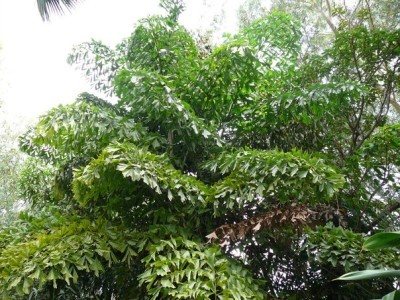

- External signs: karyote does not grow or grows poorly. Leaves, especially the lower ones, turn yellow prematurely (chlorosis).
Cause: the palm tree lacks light and / or warmth. Growth stops if the temperature is below + 18 ° C.
What to do: Move the fishtail to a warm and bright place.
External signs: young leaves turn yellow so that green veins stand out.
Cause: The palm tree lacks iron and manganese due to alkalization of the soil.
General characteristics.
Cariota is considered more than unusual, the leaf plates of this palm are special, spectacular, the shape of the crown of the palm is asymmetric, which is not typical for other representatives of this family. That is why this plant will definitely decorate your apartment. Cariota has a bizarre leaf shape, in its natural habitat it grows in humid tropical forests, which is why special attention should be paid to air humidity. However, her crown is more than amazing, despite the characteristic features of the variety, the palm is considered unpretentious and quite hardy, so you will not have big problems in the process of growing this crop. This palm tree is considered an evergreen plant, in their natural habitat they reach a height of several meters, however, trees adapted for growing in apartments are not very large, they usually grow no more than 2 m in height. These bushy palms have many trunks, so mature trees look faster like thickets, however sometimes the plants form only one trunk. The foliage of the palm tree is large, feathery, precisely because of the attractive shape of the leaf plates, the caryote is very fond of flower growers. The leaves have a different shape, so they do not have any placenta lobes, wide feathers are asymmetric, the wedges are oblique, the foliage looks as if the top of each was cut off, it is due to this originality that the palm tree has a wonderful appearance. The serration along the edges of the leaves is uneven, light, and the petioles are rather long. The foliage is in the form of irregular triangles, and the edges are usually torn. Unfortunately, this culture does not bloom at home, and even in specially equipped botanical gardens, this palm does not throw out peduncles. In its natural habitat, this plant blooms at an already very respectable age, and the palm tree blooms for only a few years, but every year.
The humid tropics are suitable for growing this plant; it is in these conditions that very beautiful inflorescences are formed in these trees. They have a branched shape, rather large, the twigs droop to the bottom, so very often the inflorescences resemble horse tails. It should be said that the palm tree blooms in stages, inflorescences are formed from top to bottom, flowers are formed in the axils of the leaves, starting from the top, gradually dropping to the base of the tree. Interestingly, the difference in flowering is so great that when the flowers bloom below, the fruits at the top of the palms begin to ripen. However, shoots die off after fruiting is complete. That is why if the tree has a single trunk, then the plant dies entirely, but if the crown of the karyote is formed in the form of a bush, then the basal processes resume the growth of the palm tree in the future, so the plant does not die completely. The inside of the fruit has sharp crystals that often damage the skin.Cariota is considered a bushy palm, so do not confuse it with other species, however, the variety of varieties in palm trees is really amazing. But these trees very often cross spontaneously to form different species, so it is very difficult to isolate pure varieties of plants in their natural habitat. However, analyzing certain similarities, breeders currently identify more than 10 species of various palms.
Of course, the plants still differ from each other, but they are similar in many varietal characteristics. Not all types of karyotes grow at home. Currently, there are two main varieties. The first of them is Gentle Cariota. These plants form many trunks; in their natural habitat, trees grow to a height of almost 10 m, but at home they are no more than one and a half meters. However, the crown of this palm tree grows intensively in breadth. It is easy to propagate this tree by dividing the bush. The foliage of these palms is rather large, wedge-shaped, and the lobes are asymmetric, denticles are noticeable along the edges, the leaves are half dissected, and a non-pointed tip is formed at the tips of the leaves. Each triangular leaf has very interesting edges. The foliage is usually wider than the length, the shoots reach 50 cm, the inflorescences are also voluminous, the fruits are red in color, and are usually small in size. The second variety of karyota is the Wine Palm. It usually has one trunk, the leaves have an asymmetric triangular shape, their tops are dissected, and the leaves are narrow, pointed. The inflorescences hang down, in their natural habitat they can even reach several meters. But the fruits of this palm are the same, red, but much larger than those of the previous variety.
Description, origin
Cariota belongs to the Arekov (Palm) family. This plant is native to tropical and subtropical regions from Asia (India, China) to northeastern Australia and New Guinea. Some species prefer to live under the crown of tall trees, while others grow in open areas. The plant has another name - "nut palm". Because translated from the Greek Cariot means - a nut.
In nature, these evergreen ornamental deciduous plants can be presented in various forms: from mighty trees with a single trunk, up to 30 m high, to small bushy plants that can form whole thickets. A peculiarity of the genus is monocarpic development - a palm tree blooms and bears fruit once in a lifetime, then dies. On average, karyotes do not live long, about 20 years, while in natural conditions their flowering period can be extended for 5-6 years.
Palm Cariota in natural conditions; on the right - a blooming palm tree
Cariota is the only genus of pinnate palms with double-feathery leaves. This means that smaller rods extend from the main shoot, on which leaf blades - feathers are located. This leaf structure is unique to the palm family.
It is almost impossible to achieve flowering at home; for this, at least a greenhouse is desirable.
Pests and diseases.
The immunity of the palm tree is average, so the plant will need to be protected from diseases and pests. If the rules of care are violated, then signs of illness may appear on the palm tree. Foliage and shoots are often attacked by pests. A spider mite, scale insect sometimes settles on a palm tree. Late blight and fusarium are considered dangerous for karyote. The plant will need to be protected in various ways, including by adjusting the growing conditions, agrotechnical methods of care. Often the foliage of the plant is washed with soapy water, do not neglect biological preparations. If any parts of the palm tree are badly damaged, then it is better to remove them. Plants are sprayed with both conventional means and with fungicides and insecticides. But with proper care, cariota rarely gets sick.
2. Varieties:
2.1. Burning karyota - Caryota urens
Single slender palms, which in their natural habitat reach a height of 12 m. Trunks are smooth, green, with small scars from fallen old leaves. At the top of the trees is a gorgeous lush crown, formed by large, arcuate, dark green leaves, each of which can reach a length of 3.5 m. The leaf segments are glossy, triangular. Abundantly branched drooping inflorescences appear in the summer months under the crown, reach a length of 3 m and consist of many small yellow flowers. Over time, the flowers turn into small, rounded berries.
Nutrition, pruning, transplanting
Caryote is fed from April to September in two weeks with a special fertilizer for palms or standard, but diluted twice.
Such leaves cannot be cut off - brown tips appeared most likely from the wrong composition of the soil
Only dead and broken leaves are cut off from the palm tree. Yellow and brownish leaves should not be cut off, as the plant draws nutrients from the dying leaves.
It is optimal to transplant a karyote in April. Since the roots of palm trees are very sensitive and tender, it is recommended to reload the plant, keeping the earth lump. It is important not to deepen the palm tree when transplanting, it should be in the new pot exactly at the same level as in the previous one. Young plants can be transplanted every year, it is better not to touch adults for 2-3 years.
The substrate for karyota must be both permeable and structured, with a pH of about 5-7. You can mix equal parts of medium pine bark and coarse peat, add some pebbles, perlite and charcoal. When transplanting, do not compact the ground too much. It is better to wait until it settles itself from irrigation, and add fresh soil.
Views
The genus Cariota does not differ in diversity and includes about 20 species. Moreover, in room culture, only 2-3 varieties are most often found.
- Cariota soft (tender)
(
C.mitis
) - the most popular type of karyota due to its small size and growth characteristics in the form of many small trunks. Therefore, at a young age, it looks more like a dense bush than a tree. As a result, the palm tree propagates relatively easily by root suckers. People call it "fishtail palm" for the special originality of the leaves, as if torn off at the edges and resembling a fish fin in shape. At home, it usually does not exceed 1.5 meters. In nature, it is this type of palm after flowering and fruiting, when the main part of the plant dies, can easily recover from the root processes. - Burning cariota (wine
)(
C.urens
) - sometimes found in tubs, but is more a greenhouse than a house plant, mainly due to its rather large size. It grows into one trunk. The local population in her homeland uses it intensively for the production of sugar, wine and sago, and also as a building material. - (C.obtusa
) or
Giant cariota
(
C.gigas
) - a native of the mountainous regions of India and Thailand, where it reaches gigantic proportions (trunk up to 75 cm in diameter). It appeared in the rooms relatively recently, it has very decorative leaves.
Room care
Like most palms, it loves bright light, but protection from the direct sun is necessary in the summer during the hottest hours. In winter, it is better to illuminate with fluorescent lamps. To maintain the symmetry of leaf growth, it is recommended to rotate the plant 180 ° around its axis every two weeks.
The optimum summer temperature of the content is + 19 ° С- + 24 ° С. The plant tolerates heat only if the air humidity is very high. The average temperature in winter is about + 18 ° C. An adult plant with a trunk can withstand a short-term decrease to + 10 ° - + 13 ° for two weeks without damage. In summer, the karyota will gladly grow in the fresh air in a semi-shady place protected from the wind.
Drafts, both cold and hot, cause damage to palm leaves.
Rather, water the karyote sparingly, allowing the soil surface to dry out between treatments. In autumn and winter, especially when the temperature drops, watering should be even more moderate. The plant tolerates insufficient watering better than frequent watering.
The air humidity should be as high as possible, especially in winter when the central heating is switched on. You can spray it twice a day: in the morning and in the evening. It is important that the water for irrigation and spraying is soft and at room temperature. Better to use rainwater or filtered water.
"Fish" greens of karyota
The singularity of the karyote becomes apparent even from a distance. But the unique leaves characteristic of this palm tree can boast of special spectacularity when the shapes and sizes of the leaf plates fully reveal the bizarre and atypical asymmetry for the representatives of the palm family. Cariotes are tropical climates who love humid conditions. But their main feature at the same time remains endurance, unpretentiousness and amazing foliage density: the appearance of this palm tree is really special.
These are evergreens, represented only by large plants of palm trees, which in nature can reach tens of meters, and in indoor culture they are limited to 1.5-2 m in height. Cariotes can grow both in the form of a single-stemmed tree, and develop in the form of bushy plants with numerous trunks, which eventually form full-fledged thickets. Leaves are double-pinnate and large. The most attractive feature of this palm tree is undoubtedly the original shape of the leaf blades. The intricately dissected leaves of this beauty attract not with classical lanceolate lobes, but with peculiar wide feathers - asymmetrical, oblique wedges, in which the top is truncated, as if the top was torn off.
Irregular triangles with "torn" edges and uneven serration seem weightless, quivering and light due to rather long petioles. It is almost impossible to achieve flowering of caryota in indoor culture; it is considered a rarity even in botanical gardens. In nature, flowering occurs at least at the age of ten and lasts only 5-7 years, but continuously. True, the caryote blooms in ideally humid conditions. The branched ears of inflorescences seem unusual due to their large size and hundreds of drooping branches, somewhat reminiscent of the shape of a horse's tails.
Inflorescences develop in the axils of the leaves from the top of the crown to its base, first appearing in the axils of the upper leaves, and then gradually the flowering wave descends. At the same time, while the bottom of the palm tree is blooming, the fruits are already ripening at the top. A key feature of this palm is the death of shoots after fruiting. Mature trees with a single trunk die completely, and bushy karyote forms are renewed due to basal processes. Inside, the fruits hide needle-shaped crystals, which are very unpleasant to the touch and can leave damage to the skin.
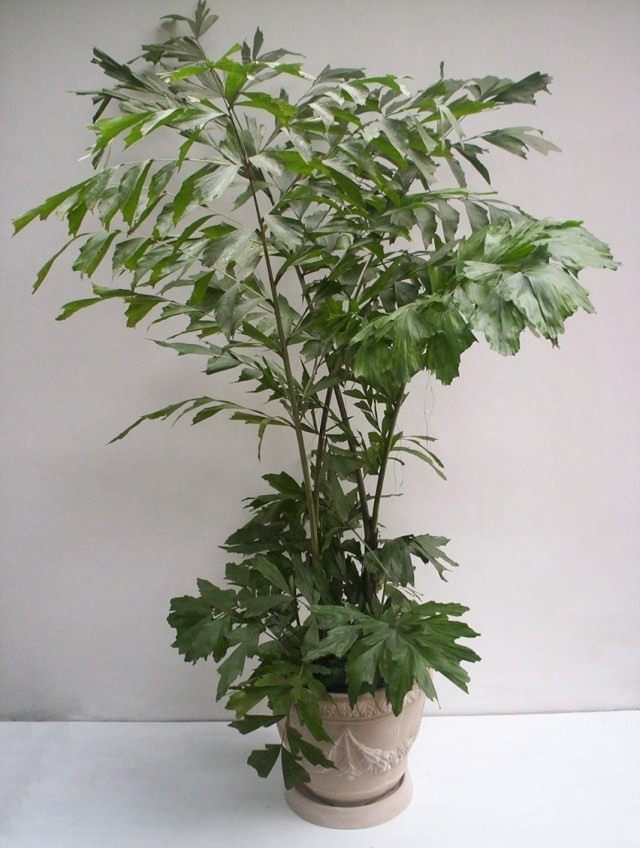

Kariota. <>
Karyota (Caryota) - bushy palms, it is almost impossible to get lost in the variety of which. Since these plants are prone to spontaneous crossing of various species with each other, it can be very difficult to determine which caryote appeared to your gaze in nature. So, despite the fact that dozens of species are distinguished in karyotes, they are all so similar to each other that specific features and species name are not significant, even their requirements for conditions are similar. But in room culture, the opposite is true. Of all the natural species of karyotes in room culture, only 2 have become widespread, and they are very easy to distinguish:
- Cariota tender, or soft (Caryota mitis) - multi-stemmed plants, in nature capable of growing up to 9 m, and in indoor culture they are limited to a height of 1.5 m, but retain their ability to grow mainly in breadth. Due to its growth form, this karyote makes it easy to get new plants by separation. The leaves of this palm are large, unevenly wedge-shaped, with lobes of an asymmetric shape with a serrated edge and a tip dissected by more than half. Each triangular leaf is 12 cm wide and only slightly longer. Cuttings from 30 to 50 cm long are quite graceful. The stem of the inflorescence is 60 cm long, the red fruits are round, about 1 cm in diameter.
- Burning cariota, or Wine palm (Caryota urens) - single-stemmed palms with asymmetric triangular leaf lobes, also a split top and slightly narrower leaves. Hanging multi-flowered inflorescences are powerful, in nature they can reach several meters. The fruits are larger and also red.

